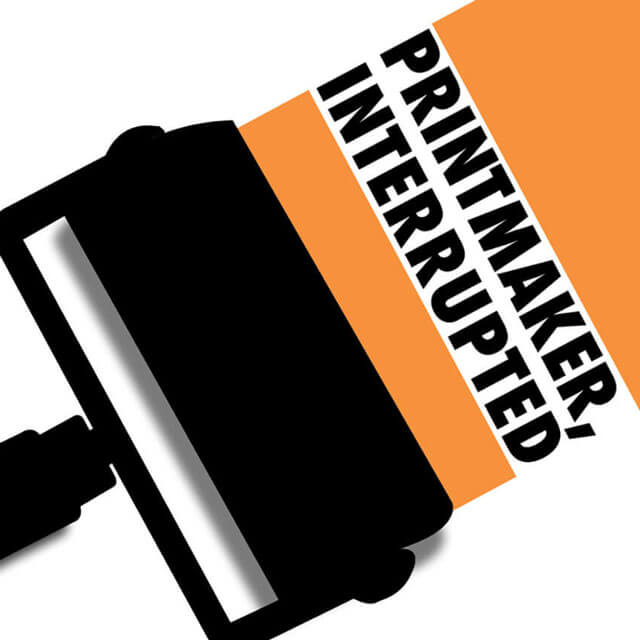
Printmaker, Interrupted
This exhibition is the result of a call for entries highlighting works created in the spirit of printmaking during the Covid-19 pandemic global response of “shelter in place” and “stay at home” conditions which displaced most art students and faculty from the facilities vital for their media. The call was open for two weeks in April 2020 welcoming all media used in the creative process as students and faculty worked from home with limited resources.
About the Organizers
Jess Dowell and Tess Murphy are the undergraduate students at Illinois State University who work in Normal Editions for independent study credit, Spring 2020. Jess is a BFA in Printmaking, Painting, and Graphic Design with a minor in Art History and Tess is a BFA in Printmaking with a minor in Women and Gender Studies. As part of work suddenly being done at home due to ‘Shelter in Place’ we thought it would be a good project to reach out to many artists who are in the same predicament where creating work in a proper printmaking studio has been temporarily interrupted. We would like to see how others are coming up with ways to make artwork in the spirit of printmaking using creative problem solving techniques.
Eligibility
This call was open to current college and university students and faculty who are experiencing “shelter in place” and “stay at home” conditions which have limited their printmaking options. Entries are digital images of the works created in the spirit of printmaking. All media were welcomed in the creative process. All work submitted must have been completed “at home” during the global response to Covid-19 in 2020.
We are excited to have 125 entries which came from 27 states and 3 countries outside the USA, representing 50 schools showing diverse and creative examples of art produced from home despite limitations while being Printmakers, Interrupted.

Maurice Sendak
Matthew McLaughlin
University of Maryland, College Park, MD
coffee ink on sidewalk
12" x 9"
2020
Using the process of Pochoir, I made a stencil with wax paper and a spray bottle with a coffee ink mixture to print this design on a sidewalk near my house to connect with neighbors through art.

The Monster Among US
Donna Moran
Pratt Institute, Brooklyn, NY
Silkscreen, paint, fiber paste on panel
20" x 16"
2020
By using collaging existing silkscreens I can produce work at home that is concerned with the restrictions and fears of our current state of affairs.

Lenny
Ezra Wilson
Guilford College, Greensboro, NC
linocut, watercolor, colored pencil, and acrylic paint on paper
5" x 7”
2020
This was created by putting acrylic paint on a linocut, printing it, then putting watercolors and colored pencil on the eyes and background.

Let 'em Have it!
Mallory Lucas
University of Louisville, Louisville, KY
digital illustration (digital silkscreen matrix)
28" x 21"
2020
This work was made for my undergraduate fine arts review, initially as a silkscreen matrix which could be printed when art facilities have re-opened. Throughout the creation of this piece, I was drawn more to the vibrant colors used in vintage WWII propaganda posters that inspired the work. As a result, I created a digital drawing with vibrant color from which I could still print silkscreen stencils in the future if I wish.

Holding Safe I
Sarah Whorf
Humboldt State University, Arcata, CA
drypoint with hand-coloring
21.25" x 13"
2020
This is a drypoint on plexi with hand-coloring done with watercolor. The most challenging was keeping my studio cat from jumping into the water soaking tray!

Holding Safe II
Sarah Whorf
Humboldt State University, Arcata CA
drypoint with hand-coloring
21.25" x 13"
Drypoint on plexi with hand-coloring with watercolor, graphite. I printed four proofs off the plexi and am working on hand-coloring variations on the proofs. Like Holding Safe I, the challenge was printing intaglio at home in a makeshift soaking set-up, and a soaking tray that was very appealing to my cat, Tater.
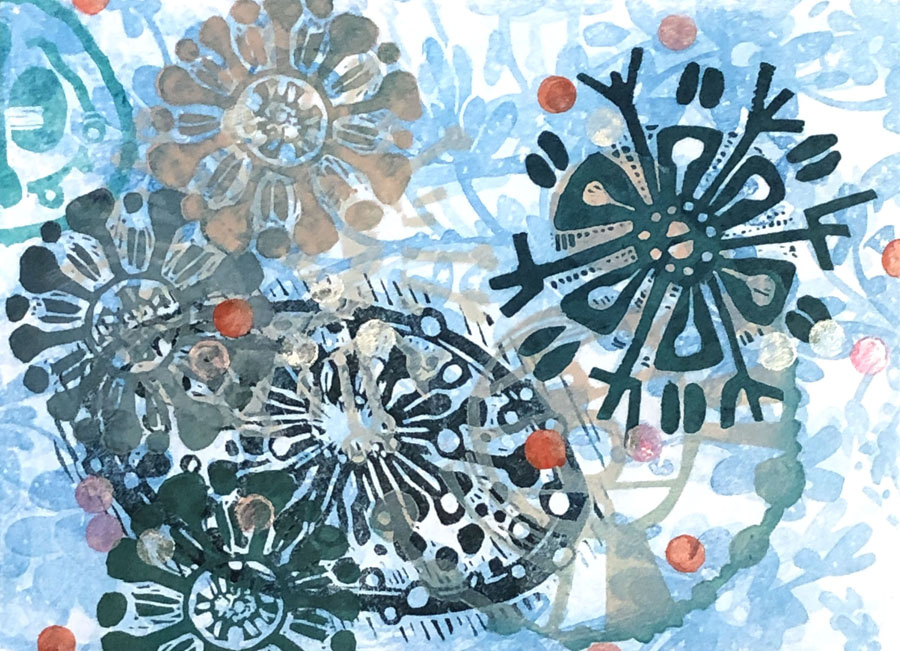
Viral Frenzy
Sarah Whorf
Humboldt State University, Arcata CA
woodcut, linocut, stamping, watercolor
4 1/2" x 6 1/8"
2020
The print has layered stamping of relief blocks. Some were printed using a Gelli plate and others were directly stamped or printed by hand using a wooden spoon. I have been making a large set of monoprints lately using the same carvings, and sending them to colleagues and friends. My idea is that I am "spreading the virus" in a safe and printerly way!

Boomer
Hugh Merrill
Kansas City Art Institute, Kansas City, MO
ink, watercolor, and digital print
4" x 3"
2020
I am making a series of small spray paint and MIcron pen drawings that resemble the language of etching. Over the past several years I have been doing a series of Photo realistic self portraits as "journal pages" combining expressionistic doodles, automatic drawings, and poetic text. I never meant to exhibit these but they are now up in the Leedy Volkos Art Center in Kansas City as part of my ongoing exhibit 2019 a years work and collaboration. This piece boomer is 3 x 4 inches and is a combination of drawing and digital print.

Hands At Home
Cody Tracy
Southern Illinois University, Edwardsville, IL
prints
10 "x 13"
2020
Gum bichromate printmaking process using the sun as UV light for exposure and a bathtub for washing the images.

Reflective Pantry
Tay Bomstein
Guilford College, Greensboro, NC
Linocut
24" x 18"
2020
This is my final for life drawing. The assignment was to draw yourself in a mirror with things that are meaningful to you. In this time of quarantine, I have found myself most thoughtful and thankful for access to food. My professor let me do a print instead of a drawing. This was my first attempt at hand printing and it was very labor intensive. I don’t have a solid method down yet and look forward to finding what works well.

“Bonjour”
Sam Oetinger and Jordan Munoz
Humboldt State University, Arcata, CA
Stencil & Stamp with acrylic paint
18" x 24”
2020
Step 1: Started with a sketch and decided on a color pallet.
Step 2: Scoured our house looking for potential stamp and stencil items.
Step 3: Taped off a border, and taped the paper to a drawing board.
Step 4: Rolled acrylic yellow with a brayer for the background.
Step 5: Cut cloud shaped stencils out of magazine pages.
Step 6: Cut up pieces of dry Swiffer Sweep pads and rolled them into stamp shapes for inking. Used tape to create a handle on the stamps for stablity’s sake. Stamped blue and white acrylic paint onto the cloud stencils.
Step 7: Cut stencils for the faces out of magazine pages and applied acrylic paint with the Swiffer stamps. Used the stamps without a stencil for some parts such as the hair.
Step 8: Used various leaves and flowers as stamps for everything in the background

My Work Will Be Art
Jiaqi Li
School of the Art Institute of Chicago, Chicago, IL
flash cards
54” X 75”
2020
The feeling of powerlessness, made me question my art and my identity. I need to talk about art to other artists (and art communities). But, my work will be art only if it is in art space; I will be an artist only if I have artwork exhibited; I will have discourse power only if I connected myself to art community.

Four Horsemen
Haley Noelle
Central Michigan University, Mount Pleasant, MI
digital
1267 x 885 pixels
2020
Throughout the course of the "Shelter in Place" order, managing my mental health has been a full time job. And for a long time, I just felt like the world was completely on fire and falling apart. That's really what sparked this piece--I was more or less waiting for some form of the end of the world. But when the idea hit me, the rest of the piece just flowed--I can't really explain it. The biggest challenge was really just letting this piece happen. It's really different from my usual style, but it represents pretty well how I was feeling at my lowest points. As far as technical challenges go, I took the opportunity to work with my Wacom tablet- I've been carrying it around with me for years but have been too afraid to use it.

Poverty
Rachel Mantel
University of Wyoming, Laramie, WY
intaglio, chiles, embroidery threads
6" x 4"
2020
In Wyoming, the economy has always been strained. I make work about the reflections of my upbringing in a small agricultural town in the desert west. As a series, I printed an average image and "solved" it compositionally with different three-dimensional ties to agriculture: dirt, beans, chiles, so on. For this print, I cut up the print, and glued it onto individual chiles. Later, I attached the chiles to a piece of BFK to hold the composition together.

Ghost
David Mohallatee
Eastern Kentucky University, Richmond, KY
PVA ( poly vinyl adhesive) paperback books, cut paper
9" h x 5" w x 8" d
2020
These pieces examine the use of non-conventional or “Low Art” materials drawing an awareness to turning everyday materials in to interesting pieces of artwork. These artist books made from materials that have served a purpose, made in sets or editions, similar to traditional prints and made from books taken from my personal library. With an attempt to propose new potentials, purposes and use for these materials. This practice of adaptive reuse and upcycling of materials; giving them a second life.

Maine, 2015
Kaitlyn DiBiase
Bowling Green State University, Bowling Green Ohio
18.5" x 15"
2020
Completed April 3rd, 2020. Moving towards a printing technique from home has been challenging in that I had to learn how to modify my ink just enough to be able to hand burnish the block, while creating a space that allows me to continue making the style of relief printing that I have only ever done using a printing press. By transforming my living room into a print studio, using a glass baking dish as an inking surface, and walking over the back of my prints to transfer as much ink as possible, I learned to enjoy the process of printing from home!
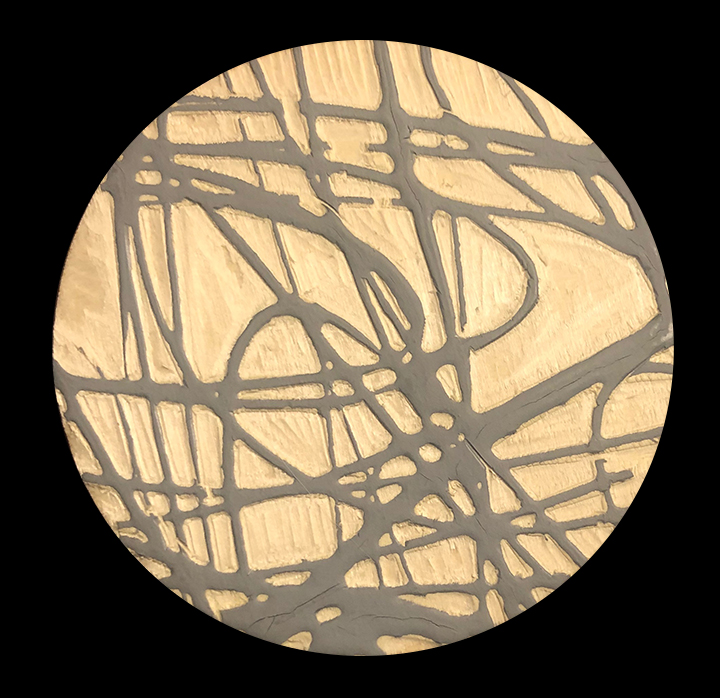
containment coaster
Sarah Kinard
Rochester Institute of Technology, Rochester, NY
woodcut
4" x 4"
2020
I created a line pattern by using a brush, house paint, and a wooden coaster. Using the weight of color, I directed the paint as it fell from the bush to generate a radial motion. I relied on chance and intuition to create the composition.

Ice Object #1
Carley Schmidt
University of Wisconsin-Madison, Madison, WI
cyanotype on handmade abaca paper
6" x 6"
2020
I coated handmade abaca paper with cyanotype photo emulsion in my bathtub with the lights out. It was difficult to see, and I only had a small foam brush, so I chose to work on a small scale. I took my sheets of paper to Lake Mendota, one of the lakes that create the isthmus in Madison, where ice from the winter freeze had piled up along the shore as the lake began to melt. I sat a piece of ice atop each piece of paper, and let ice melt as the print developed. The melting ice created a bleed affect and a tonal range. I used unsized paper so that when I soaked the papers after exposure, I could sculpt them into new forms. Each object represents a tiny, melting glacier.
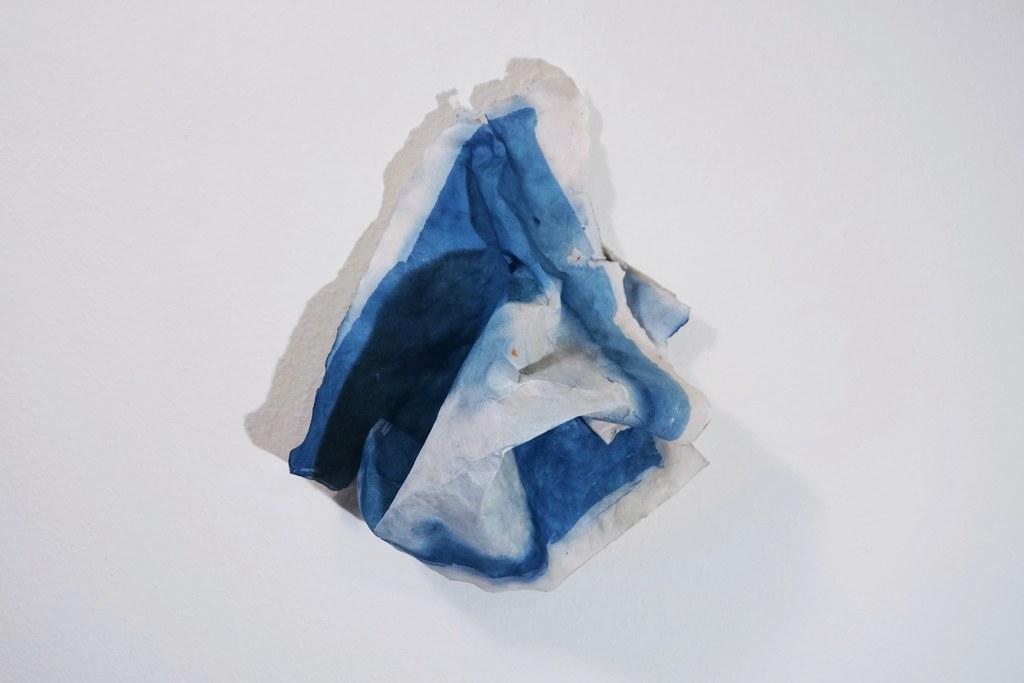
Ice Object #4
Carley Schmidt
University of Wisconsin-Madison; Madison, WI
cyanotype on handmade abaca paper
10" x 7"
2020
I coated handmade abaca paper with cyanotype photo emulsion in my bathtub with the lights out. It was difficult to see, and I only had a small foam brush, so I chose to work on a small scale. I took my sheets of paper to Lake Mendota, one of the lakes that create the isthmus in Madison, where ice from the winter freeze had piled up along the shore as the lake began to melt. I sat a piece of ice atop each piece of paper, and let ice melt as the print developed. The melting ice created a bleed affect and a tonal range. I used unsized paper so that when I soaked the papers after exposure, I could sculpt them into new forms. Each object represents a tiny, melting glacier.

Ice Object #7
Carley Schmidt
University of Wisconsin-Madison; Madison, WI
cyanotype on handmade abaca paper
6" x 6"
2020
I coated handmade abaca paper with cyanotype photo emulsion in my bathtub with the lights out. It was difficult to see, and I only had a small foam brush, so I chose to work on a small scale. I took my sheets of paper to Lake Mendota, one of the lakes that create the isthmus in Madison, where ice from the winter freeze had piled up along the shore as the lake began to melt. I sat a piece of ice atop each piece of paper, and let ice melt as the print developed. The melting ice created a bleed affect and a tonal range. I used unsized paper so that when I soaked the papers after exposure, I could sculpt them into new forms. Each object represents a tiny, melting glacier.

To The Void
Anna Yates
Bowling Green State University, Bowling Green, OH
To The Void
woodblock print
26" x 18"
2020
While relief printing is one of the easier printmaking processes to bring home, to print a larger scale (especially without a press) takes a lot of patience. For the carving of the block, I used both Japanese carving tools and a drill with a steel brush Dremel bit stuck in it, to achieve those more "painterly" strokes. I printed it using a wooden spoon and the bottom of an ink can over the course of about 7 hours. While printing areas of solid black can feel tedious, they also provide a space of meditation about my work to get lost in, and it's this sort of space where I revel.
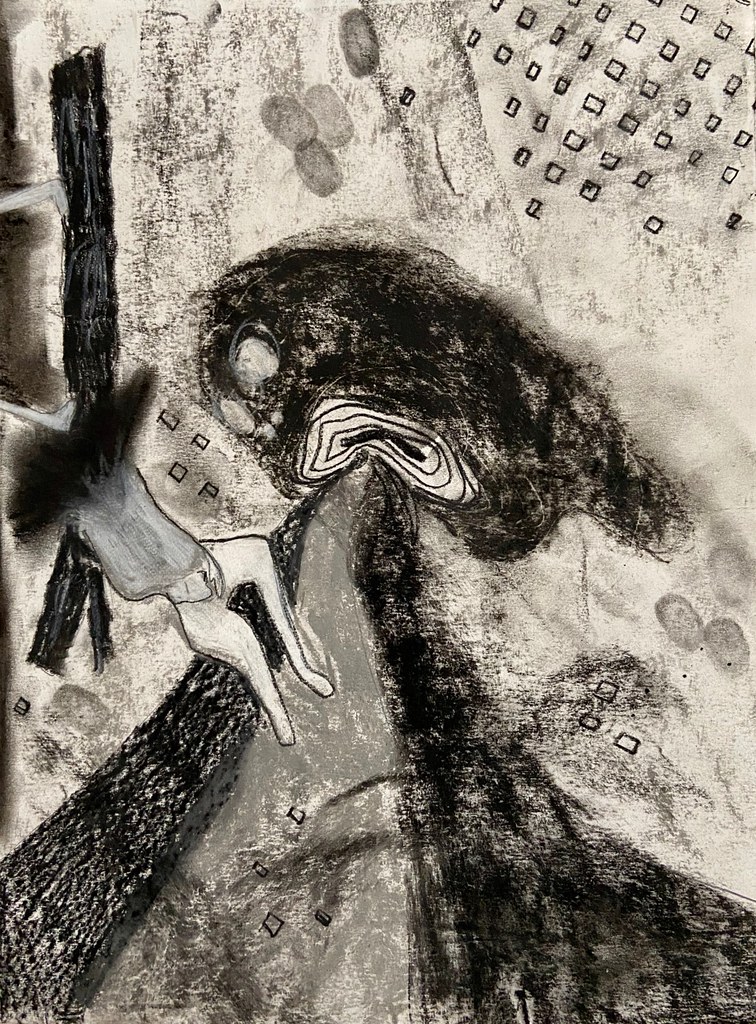
What is Reality?
Breanna Rechtenbaugh
South Dakota State University, Brookings, SD
charcoal frottage
11 7/8" x 9"
2020
Stuck inside my house and unable to go to the studio, I made a frottage using surfaces around me. I used my bedroom wall, texture from the cover of my sketchbook, the spiral of a notebook, my wood desk, my finger prints, smudging, and a tennis racquet.

Agave Guy
Kristen Bartel
University of Wisconsin-Parkside, Kenosha, WI
linoleu and plastics on handmade paper
12" x 15"
2020
I store a lot of my raw materials at my university office/studio. When we got about 24 hours notice to pick up needed supplies for teaching a creative activity before the building was completely locked, I scrambled to get what I needed for teaching and neglected to pick up extra paper, plate, drawing tools, etc. I am lucky that I have a small home studio with a press. I am spending time reworking old plates from around the studio and printing on a stack of paper I made with my students a couple of years ago. I've also spent a lot of time reflecting on old artwork. It's been rewarding to slow down and think about the potential of "old" things.
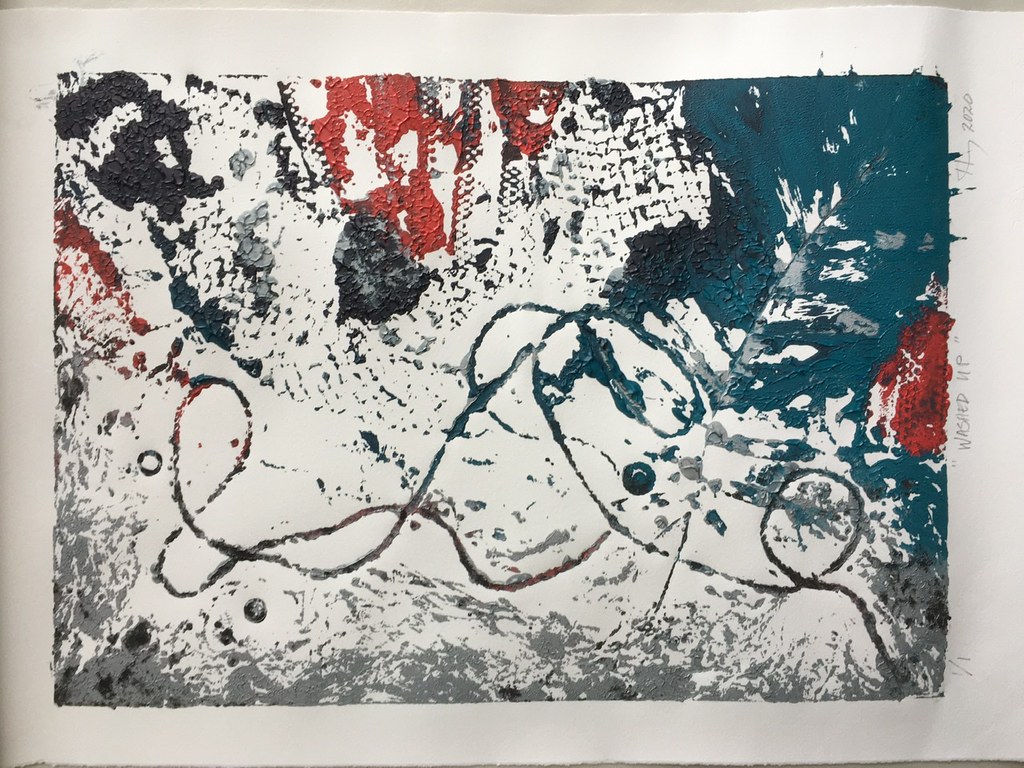
Washed Up
Holly Patton Shull
University of Louisville, Hite Art Institute, Louisville KY
collograph relief print, speedball water soluble ink on BFK Rives
15" x 22”
2020
I have a small studio apartment with a work space designed for painting. This work was created to fulfill an assignment for my Printmaking class. I scavenged various items that I had at hand (including fabric, tissue paper, avocado bag mesh, twine and palm leaf). I arranged on a piece of illustration board and glued. After dried and inked, I sandwiched between paper on my floor. In place of a press, I laid my drawing board on top and methodically walked over the board.

"For Lauren"
Sarah McClymond
Kennesaw State University in Kennesaw, GA
linocut
12" x 9"
The move from the safety and convenience of the studio was really hard. During this time of "shelter in place" I also have a broken ankle which has doubled the time and energy required to continue to create. I found the process of carving the lino much the same that it would have been in the studio, making sure to order the correct tools for the job, but I had to find interesting ways to print it. I didn't have an inking plate so I used a paint palette. I didn't have a barn so I used wooden kitchen spoons. And as many printmakers know, it takes a bit more elbow grease to hand print rather than use a press! Im grateful I was able to order and use real printmaking ink, although I'm not sure I used the right kind of paper! A great and challenging experience and I'm very happy with the result. Made for a friend.

I'm Safe (and Imprisoned)
Allison Denny
Western Kentucky University, Bowling Green, KY
linocut
12" x 12"
2020
I was inspired to create this piece by my surroundings, and how Covid19 has been making me feel. I wanted to capture the feeling of being trapped and confined in my home, a place that used to be a refuge. My printmaking professor was able to switch us all from the intaglio process to relief to have us still able to print while staying at home. The biggest challenge was getting a clean, even print without a press at home; I was able to use a can of Diet Coke as a brayer.
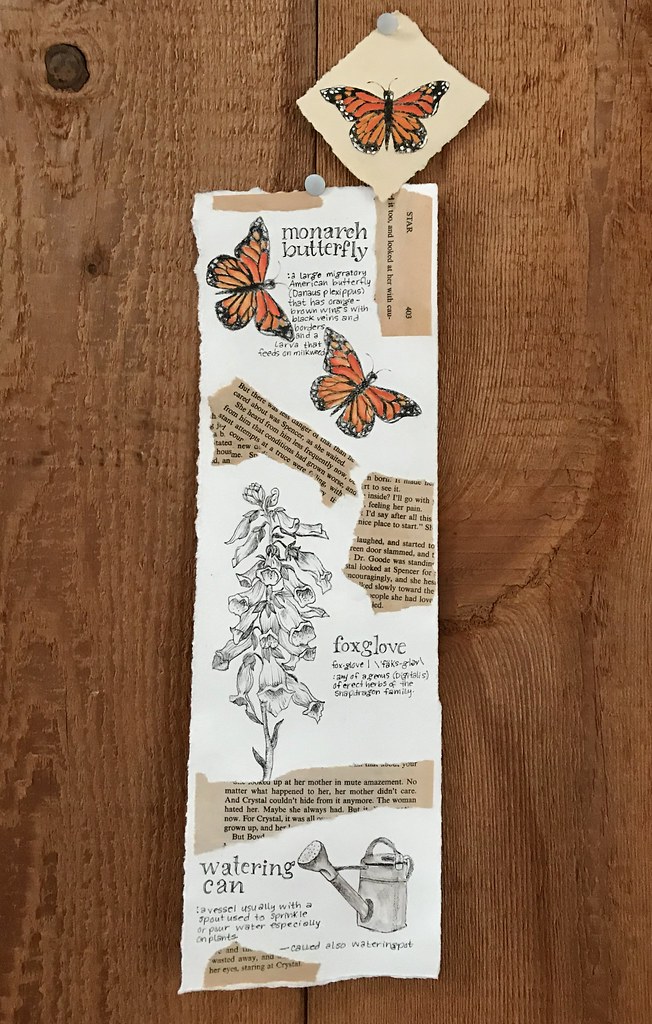
Spring In The Air
Autumn Doney
SUNY Oneonta, Oneonta NY
plexiglass printmaking
12" x 4"
2020
Due to the COVID-19 outbreak I have had to learn a whole new process from home. This piece is made from etchings in to plexiglass, before this my prefered medium was Zinc Aquatints which were substituted with plexiglass for the rest of the semester. I found it most challenging going from a group studio working along side my peers being able to give one another feedback and learning from one another to working alone from my desk at home. In the studios at the college, we had unlimited supplies as well as a press where as now I am working with limited materials and have had to improvise. I hand printed this piece using a plexiglass plate adding in collaged paper. The piece was inspired but an encyclopedia page giving the description of the etching along side it. Despite this being a completely new process and having to learning to work alone with limited resources and space has caused me to have to be more creative with the process.

"Labor Of"
Amit Cassandra Ben-Baruch
Maryland Institute College of Art, Baltimore, MD
markers, ballpoint pen, drafting paper
18.75" x 18.75"
I initially began these pieces as explorations of color relationships, and I also intended on using them as "sketches" for a quilt that I am in the process of sewing. After completing a couple of these drawings, however, I began to notice that the marks from one drawing would bleed through onto the paper on the pad beneath. Due to the thin nature of the drafting paper that I was drawing on, I felt compelled to use this discovery to my advantage. I immediately began to notice the similarities between this process and the idea of pulling a ghost print. In addition, as I drew more of these squares, the idea of a plate going through multiple states was one that I thought of repeatedly. I drew for 8 hours a day for 3 days straight, and these 25 squares were the result. It felt like a marathon printing session with the result being an exciting "varied edition." I'm very fond of these because they have shown me how discovery can happen even during a tragedy. Despite me not having access to the print studio, I was able to experiment in ways and use multiple mediums to my advantage in a way that I likely wouldn't otherwise have had the chance to.

Lucid
Peytin Fitzgerald
Illinois State University, Normal, IL
graphite, micron pen and collage
17" x 19"
2020
I used materials that were readily available. In my original practice this would have been a print where I would have manipulated each differently. The image is hung in the window because I have enjoyed the way that the window enhances my work in a different way.

Green Form #1
Kate Forer
Southern Illinois University Carbondale, Carbondale, IL
folded relief prints
8.5" x 3.5" x 3.5"
2020
This is part of a series of experiments conducted in April 2020. Without access to the school's printmaking studios, I was advised to try making relief prints from non-traditional objects. I decided to experiment with printing a sculptural form made from modular origami. Once I had printed the texture from the sculpture, I decided to try cutting up the prints and recreating a similar form form with the new paper, creating a recursive texture that is both stamped onto the surface and formed by the material itself.
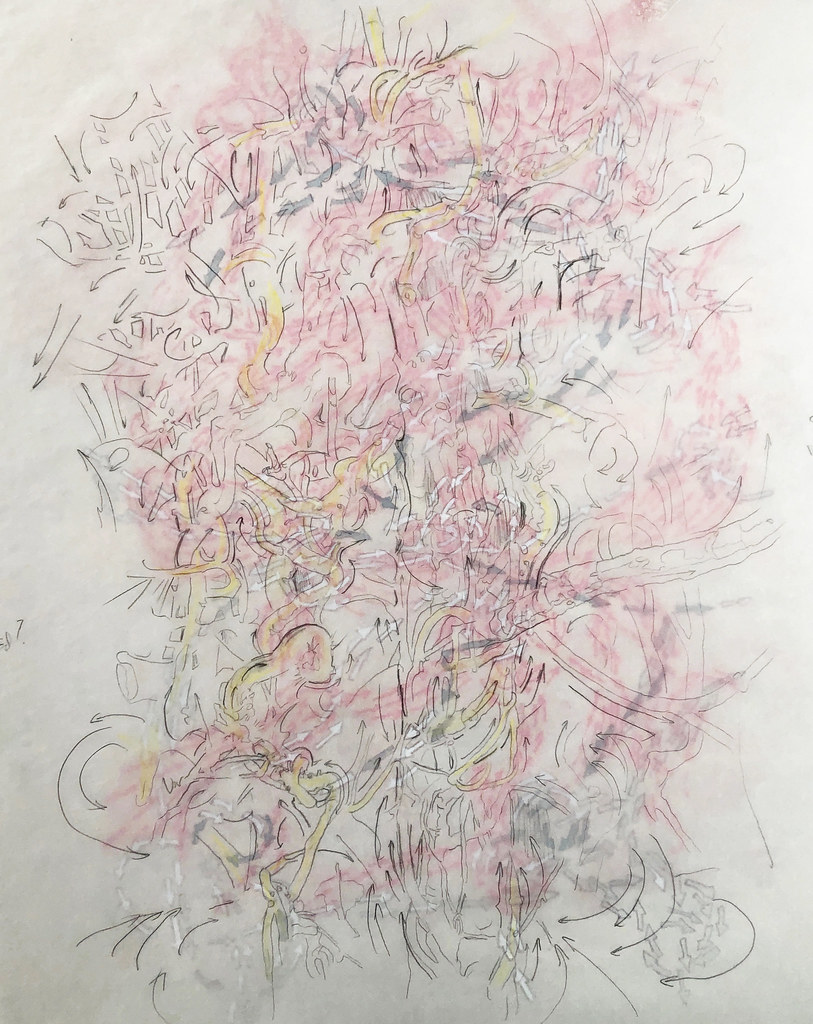
Tangle (Pink Arrows)
Catherine Chauvin
University of Denver, Denver, CO
trace monotype, tracing paper, pencil and hand coloring
19' x 12"
2020
I'm currently in Ireland under lockdown while visiting the Burren College of Art.
I have a glass topped kitchen table, 3 tubes of oil paint (white, yellow ochre and cadmium red). I also have an icing knife (for mixing color) and a soup spoon for printing. Trace monotype is super low tech and printing the relief left after is visually intriguing for me. The time afforded to do more complex layers is wonderful - the tracing paper has become another layer, while maintaining the spirit of print.I'm learning how many obstacles everyone at home is working with every day as well.

Simon Mason_90870074_theresa
Simon Mason
Concordia University, Montreal
digital
2000 px x 2500 px
2020
This was intended for an assignment using digital printmaking techniques (photo plates) however, since i am no longer able to access the lithographic studio, I am unable to print it. I wanted to express feelings around food which can be something that is both pleasurable and painful. Currently many people are in isolation, and some are unable to access food while others feel that they are not eating the same way they usually do because of their routine being interrupted.

Slow Burn
Macy Reynolds
Indiana University Southeast, New Albany, IN
lino cut and ink on kraft paper
8.5'' x 8.5''
2020
Because I was relief printing at home, obviously I had to create without using the wonderful printing press, so achieving a nice, even, ink coating was a challenge. I made do with a metal spoon and my Speedball baren. Although I was working from home, I had all my gouges, linoleum and ink to be able to print. I started by sketching my design on my Lino block with pencil, then tracing over it with thick Sharpie. After I was finished drawing, I carved the design and began the printing process.

"Breathe"
Merrick Adams
Rhode Island School of Design, Providence, RI
ink on paper
22" x 30"
2020
I am currently using ink washes to create reimagined WPA style posters. I have been viewing these satirical drawings as a time capsule of my own experiences, the experiences of those around me, and as way of filtering and purging the seemingly endless absurdities that are being spewed by politicians, individuals, and news outlines across the world. Therefore, the text questions the the current redirect being used and forces the viewer to confront the absurdity of the language and position the poster is "promoting".

"Phillip el Nopal"
Leslie Mata
Southeast Missouri State University , Cape Girardeau, MO
screen-printed soft sculpture
17" x 11.5"
2020
When I was creating this art piece, I had no access to an exposure unit. I had to improvise and use fluorescent light bulbs that I had in my basement and a piece of glass to expose my screen. I then screen-printed the face on the green fabric. Once it dried, I glued thumbtacks from behind to give this cactus some thorns and sewed it closed.

The Path that Leads Us
Roberto Torres Mata
University of Wisconsin-Madison, Madison, WI
lithograph, screenprint
30" x 44"
2020
The print itself was a challenge, considering the size and difficulty with multiple colors. This print identifies the realities of migration with the somber flock of birds that make the waypoint for the migrants to follow.

Fried Eggs over White Rice
Taylor Guntharp
Minneapolis College of Art and Design, Minneapolis, MN
digital illustration
11" x 8.5"
2020
This is one of the first projects I did after my Intaglio class transitioned to being an online class. This was also my first semester working with Intaglio process and, though my time in the print shop was short, I felt as though I had grown a pretty intimate understanding of a few etching and printing techniques. I have a comfortable understanding of digital illustration and found the process of interpreting etching techniques (such as hardground and aquatint) to transferred well in this medium because of it's texture friendly interface. During my time with Intaglio, I had, unknowingly, created an ongoing theme in all my prints around the concept of people and food (interacting with, cooking, etc). Being able to carry this theme with me has provided one of the few unchanging aspects of my daily life and helped guide me in this new chapter of the semester and my life.

After School Art
Jill Adler
Pennsylvania Academy of the Fine Arts, Philadelphia, PA
rubber linocut
4.5" x 8"
2020
As someone whose exclusive printmaking method was screenprinting, I was incredibly disappointed that all physical studios would be closed for the foreseeable future. I have been using this opportunity to teach myself relief printmaking from home, and have been using whatever rubber and linoleum I can find. This is my first-ever relief print, and I used two small pieces of Speedball Speedy-Cut rubber that I found in a closet to make it. I have been using a sheet of waxed cardboard as my ink-rolling area, and made a registration jig out of tape and cardboard. Since I do not have access to a press, every print is pressed by hand with a bone folder.

Self Portrait in Front of Mirror
Brandon Huelskamp
Kennesaw State University, Kennesaw, GA
ink on paper
6 1/2" x 6"
2020
During the time of shelter in place orders I as an artist have a lot of time to examine myself and my limited surroundings. The current climate of the world is almost surreal and something that most if not all of us are not familiar with. We must take a step back and begin to think of the way we live and rethink what is "essential" and what is not. This time has afforded me the opportunity analyze my own lifestyle and makes one wonder what habits will be learned today and which ones will be left in the past. I created this print to visually represent these thoughts I've during times of isolation. I was fortunate enough to have a spare relief block around the house before stores began to close. Created on 04/11/2020.

Apparition of Keys #12
Johnny Plastini
Colorado State University, Fort Collins, CO
cyanotype on Rives BFK
11" x 8.5"
2020
For the months of April and May 2020 I’ll be making a series of cyanotypes from home utilizing antiquated keys and solar exposure methods. Historically, I view these prints in-line with Giorgio Morandi’s repetitive vase/bottle paintings and prints in domestic spaces, although instead of vases, I’ll be working with the same set of old keys for 60 individual cyanotypes. The keys will shift in different configurations for each image, but will remain confined at the same scale of 8.5” x 11” on Rives BFK. I’m doing two a day, in the morning and at evening when the shadows are long. Like we all are, I’m thinking simply about containment and being locked out of spaces and locked into spaces, both physically and psychologically during the Covid-19 pandemic.
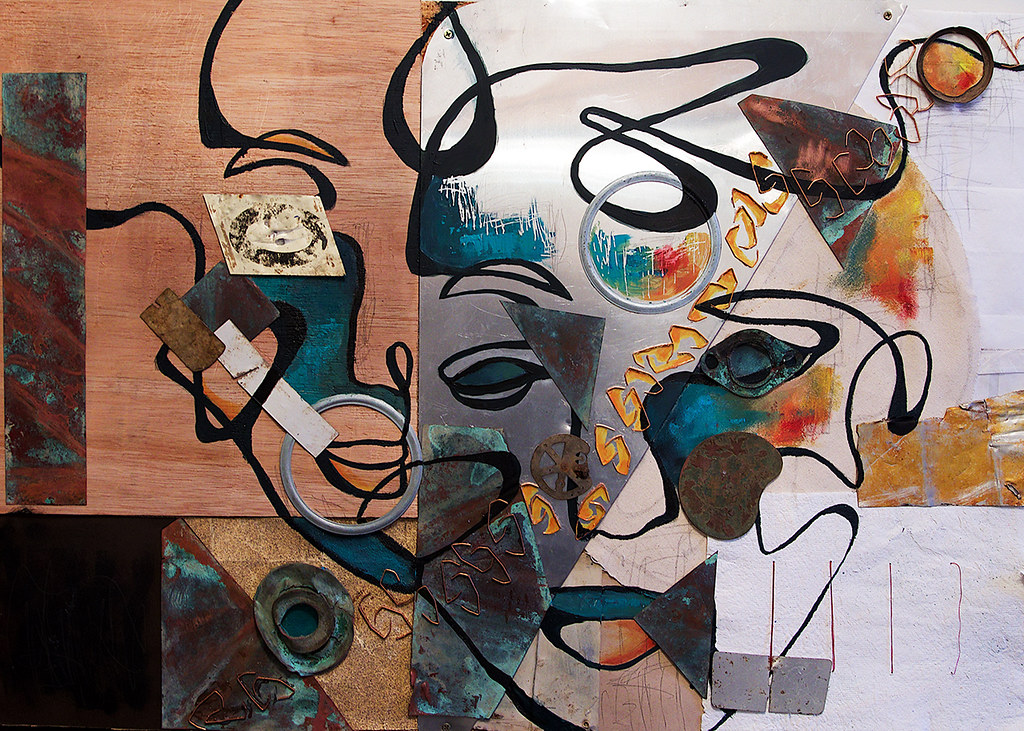
Healing
Lydia Hershauer
Central Michigan University, Mount Pleasant, MI
wood panel, recycled miscellaneous metal, sandpaper, card stock, backside of an old aluminium litho plate, handmade paper, canvas, paper bag, dryer sheet, thread, acrylics, copper staples, graphite
34" x 24"
2020
To make this piece, I used scraps of materials that I could find in my house. I cleaned and flattened the recycled metals, scratched into the wood, cut down the materials, and threaded into the paper. From there, the challenge was to find a way to compose and adhere them together. I used a couple of screws, but most materials were glued. This included putting glue down, putting the material down, and then placing heavy objects on top to let it dry overnight. Acrylic paint was added and reacted differently depending on what surface was being painted on. Some areas had to be painted over multiple times. I used another scrap of metal to scrape away some of the paint. Pencil scribbles were added as the last step.
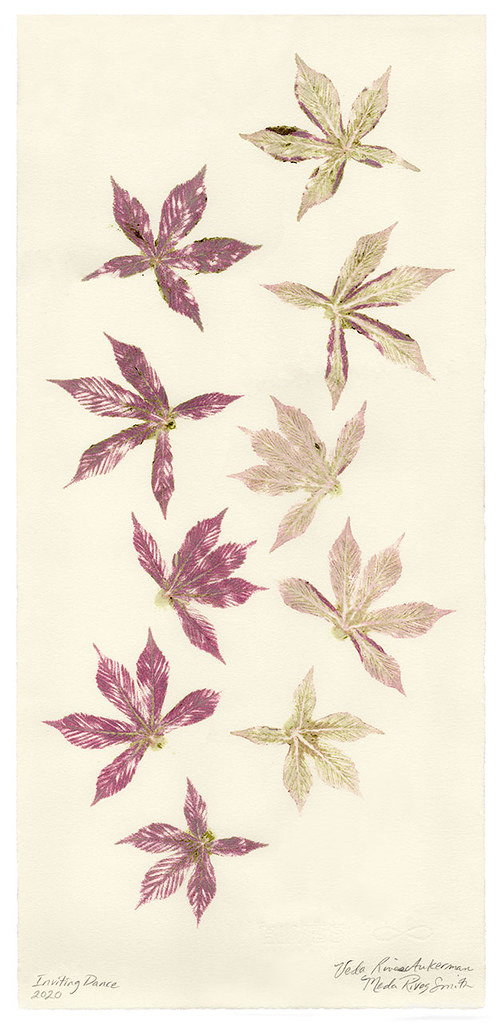
Inviting Dance
Veda Rives Aukerman & Meda Rives Smith
Illinois State University, Normal, IL
hammered leaves and digital techniques
15 1/2" x 7 1/2"
2020
This collaborative work started with hammering leaves from the garden between sheets of Rives Heavyweight paper to directly transfer the pigment by the crushing action. The image was finished digitally to adjust the arrangement of the leaves in the final composition.
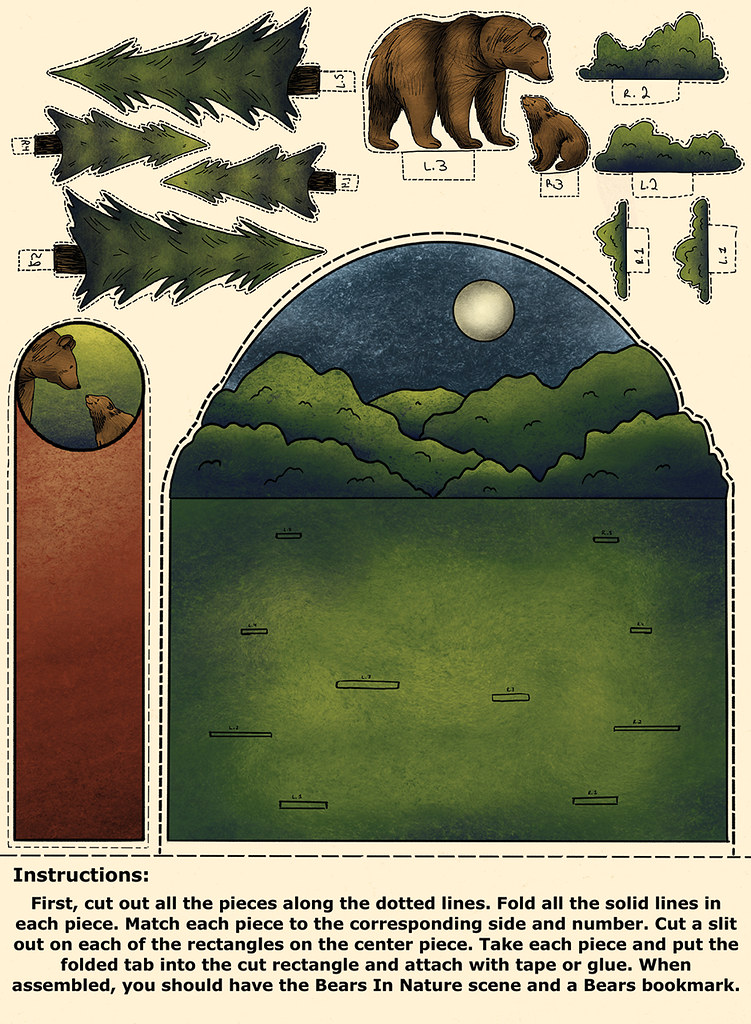
Bears in Nature
Emily Bealer
Indiana University Southeast, New Albany, Indiana
digital print
11" x 15"
While we are all self-isolating, I wanted to challenge myself to make something that could help with how we are all feeling. I created an artwork that was simple, easy to use, and interactive for anyone. I designed this to originally be screen printed and plan to once we are allowed back into our studios.
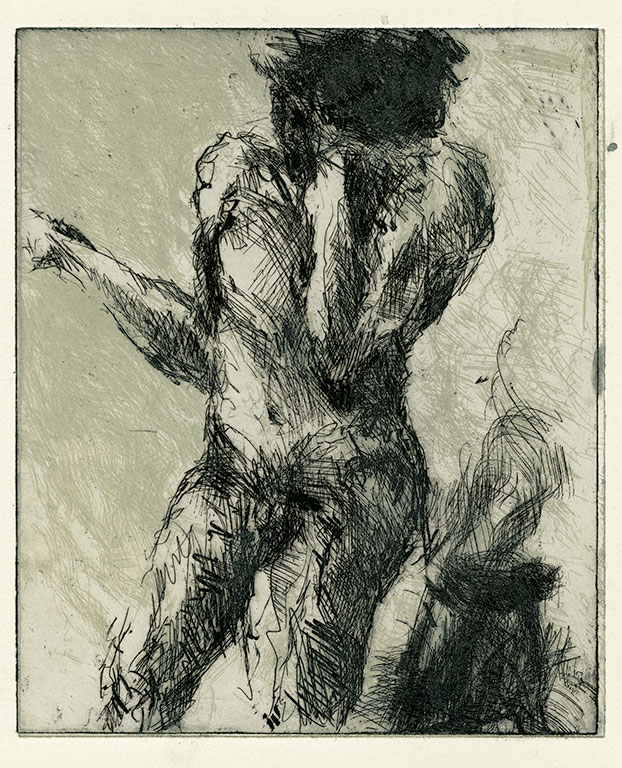
rest
Sean Topel
Carleton College, Northfield, MN
intaglio
9" x 7.5"
2020
In the absence of figure drawing sessions, I looked back to my old gestures, and drew on those for inspiration. From this removed setting, I translated a linear, gestural drawing into a more developed scene. I have tried to leave an ambiguity in the print that comes from this imaginary figure drawing session. Through this ambiguity, I am conveying that the wholly observational approach has failed due to shelter in place conditions.

Stack on Fire
Steve Garst
University of Indianapolis, Indianapolis, IN
wood engraving
6" x 4"
2020
This print was drawn, carved, and printed with a spoon at home.
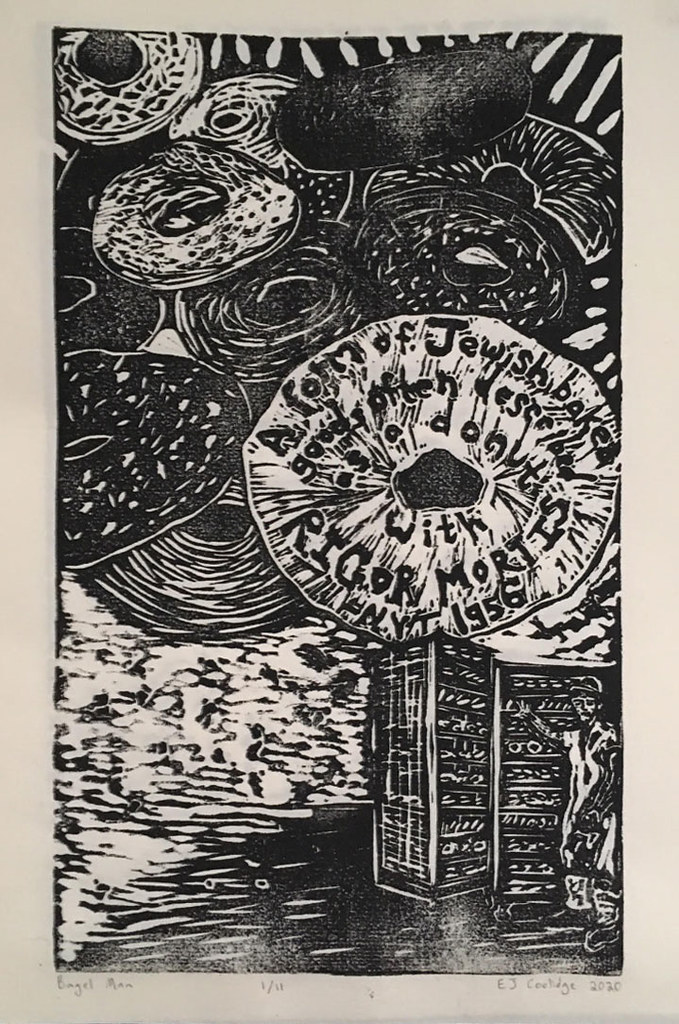
Bagel Man
EJ Coolidge
Macalester College, St. Paul, MN
lino cut
10" x 6"
2020
While quarantined in my apartment I was flipping through Joan Nathan's /Jewish Cooking in America/ and a photo of a man standing proudly next to his bagel racks caught my attention, as did this morbid definition courtesy of the New York Times, 1956. This print is an homage to the history of bagels (but not the blueberry or cinnamon crunch varieties...).

Playground
Cedar Heffelfinger
Carleton College , Northfield, MN
intaglio
6" x 8"
2020
Online art classes are so odd, especially because one thing I love about the classroom is wandering around seeing others' work. It excites me to see others' creative process and drives mine too. This process was a lot more secluded but also the indirectness of intaglio was heightened because our professor etched and printed our work (so grateful for all his time!) but it is a bit bizarre. When i saw the final product I felt quite shocked. Yet also curious because what I imagined it to be and what it came to be, begged me to look at again. I began to feel fondly towards it even though it didn't come out the way I intended. It sat in itself: an individual. making art right now (particularly prints) is in a way making new beings, new friends; which is so needed!
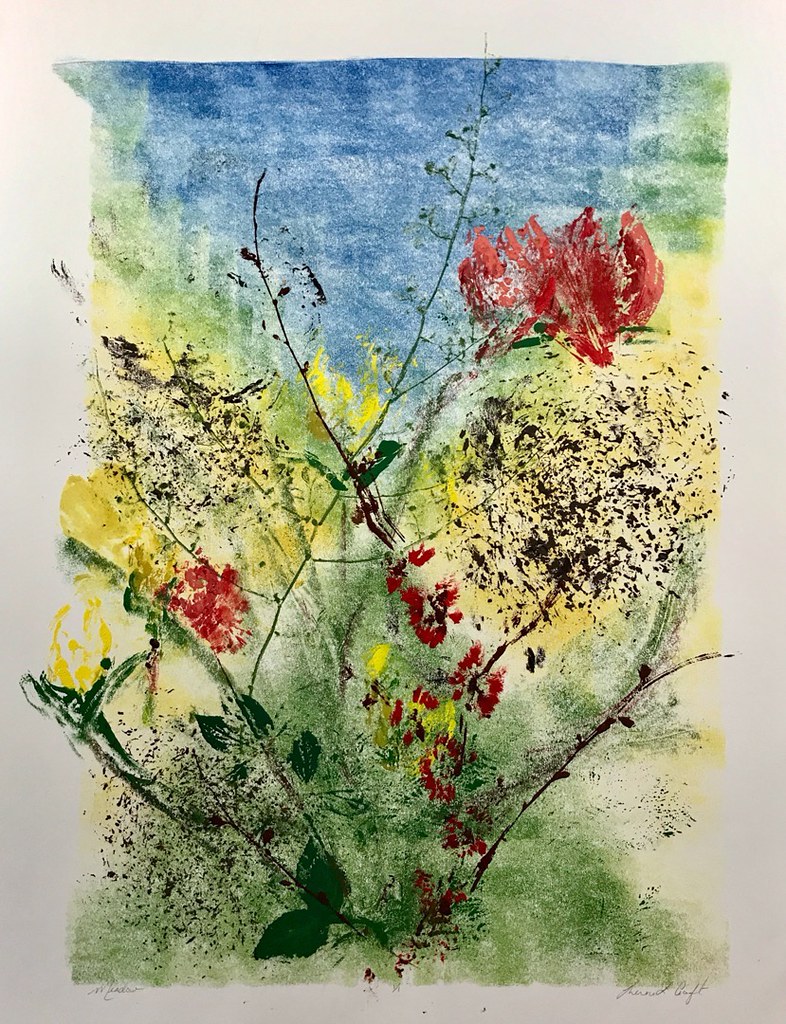
Meadow
Therese Croft
Illinois State University, Normal, IL
printing ink on BFK Rives paper
30" x 22"
2020
This is a large monoprint. I used a plexiglass base for the ink platform and foam rubber "brayer" to lay the ink out. It was challenging to get a true even press by hand. I used a wooden rolling pin as my "press". Some of the forms are imprints from inked stems and flowers from the garden.

untitled
Therese Croft
Illinois State University, Normal, IL
printing ink on BFK Rives paper
7" x 5"
2020
This started as a ghost draw from a larger field. I liked the swirl of the yellow and blue. I then laid a cedar branch down and inked around it to create the void. Stamping with Viburnum leaves finished the right bottom. A branch detail is added using India Ink and quill. This is the left side of a triptych.

untitled
Therese Croft
Illinois State University, Normal, IL
printing ink on BFK Rives paper
7" x 5"
2020
This started as a ghost draw from a larger field. I liked the swirl of the yellow and blue. The 2 ,5x7 fields have a continuation of the background swirl. A branch details is added using India Ink and quill. Imprints of cedar stems create the organic form on bottom left. This is the right side of a triptych.

Fingers
Kristen Byrne
Penn State, University Park, PA
watercolor and acrylic
7" x 6"
2020
Layer a flat wash of watercolor down, dipped fingers of myself and those I’m social distancing with into acrylic paint and placed on paper in a pattern like arrangement.

The God of Wealth
Yanqi Sun
Central Michigan University, Mount Pleasant, MI
screenprint
11" x 8.5"
2020
Find a balance between similar to Chinese traditional images and differences.

"Playing Alone"
Jessica Dehen
University of Miami, Coral Gables, FL
mixed media (silkscreen monoprint manipulated with acrylic, colored pencil, marker, oil pigment stick)
29.50" x 21"
2020
The week before my university closed down due to the COVID-19 pandemic, it was spring break. My professor made the time to come into the studio anyway to show me some silkscreen techniques for creating monotypes... and I fell in love with the process, only to be banned from the printmaking lab a week later. I had every intention of using the remainder of my term to experiment with silkscreening methods but due to all of my materials and supplies being located on campus, I had nothing but extremely early stages of work to bring home with me. This print is a result me using the only materials I had access to in order to further manipulate the work. Paint, oil pigment sticks, colored pencils and markers were layered on top of the original silkscreen image to add the depth and intricacy that I had hoped to achieve via the silkscreening process.

Anywhere But Here
Jessica Dehen
University of Miami, Coral Gables, FL
Mixed media (silkscreen monoprint manipulated with acrylic, colored pencil, marker, oil pigment stick)
24" x 16"
2020
The week before the COVID-19 pandemic prompted my university to close its' campus, it was spring break. While other students were home or vacationing, I was in the print shop with my professor. She had agreed to meet with me and demonstrate some silkscreening techniques and I fell in love with the process... only to be banned from campus and access to all printmaking materials a week later. I gathered what I could before the university shut their doors, which were only a few early starts on some silkscreen monoprints that I had hoped to further layer on top of. The image produced is mixed media silkscreen print using the only materials that I had access to from home. Acrylic paint, oil pigment stick, colored pencils and markers were layered on top of the silkscreen in order to add the layers and intricacy that I had hope to achieve through the silkscreen process.

When it was sunset.
Elena Masrour
Kansas State University, Manhattan, KS
monoprint
14" x 11"
This is a simple monoprint made by Sepia ink and brush. I did not have my plexiglass at home. So, I used the glass of one of my frames. I layered the ink and started drawing with brushes. After that, I made a print and then used my pen to create lines.

Pinocchio and Pinocchette
Phyllis Bramson
The School of the Art Institute of Chicago, Chicago, IL
collage and mixed media
14" x 8"
2020
following my instincts and improvising as I go along I have no set process

Jiving on Sol LeWitt
Phyllis Bramson
The School of the Art Institute of Chicago, Chicago, IL
collage and mixed media
18" x 14"
2020
following my instincts and improvising as I go along I have no set process

Growth
Jess Dowell
Illinois State University, Normal, IL
charcoal collage
12" x 9"
2020
This is a work made with charcoal and handmade paper. Without having access to the proper materials, I was inspired to make a charcoal drawing, layering the pieces on top of one another. The way I work on a monotype is to have a base layer, a textured layer, and a hand drawn element, so this is very similar to that process.

Lonely Cyclist
Nesto Yero
University of Wyoming, Laramie WY
monotype
15 3/8" x 12 1/4"
2020
When making a work of art, drawing or printing or painting something, I am explaining something. I am explaining what I am feeling. I am explaining what I have been through or experiences I hope to have in the future. The most important part of the process is the conversation with the white noise of my mind. The act of making is very important to me. It holds my attention because of its meditative aspects. This restful state allows me to observe the crazy movements of this world clearly, for this world around us is not the same as it was a moment ago. This quiet conversation with my consciousness is then, both internal and revealed. And so I make my place in the world by making part of it. Each new piece of my art enlarges our reality. The world is not yet done.

untitled
Nesto Yero
University of Wyoming, Laramie WY
intaglio
5 7/8" x 3 7/8"
2020
When making a work of art, drawing or printing or painting something, I am explaining something. I am explaining what I am feeling. I am explaining what I have been through or experiences I hope to have in the future. The most important part of the process is the conversation with the white noise of my mind. The act of making is very important to me. It holds my attention because of its meditative aspects. This restful state allows me to observe the crazy movements of this world clearly, for this world around us is not the same as it was a moment ago. This quiet conversation with my consciousness is then, both internal and revealed. And so I make my place in the world by making part of it. Each new piece of my art enlarges our reality. The world is not yet done.

Zoom transfer drawing
Judy Glantzman
New York Studio School, New York, NY
oil paint on paper
14" x 11"
2020
I have a session in the beginning of class where we draw each other on zoom. I inked up a 8"X10" paper with oil painting a breyer. I lay the oil paint side down on an 11"X14" paper, and draw. The realist in an ink transfer.

"Iterations Series"
Sue Hettmansperger
University of Iowa, Iowa City, IA
collage of lithographs, digital images and oil paint
5" x 5"
2020
Cutting images from 2 identical litho prints, and 2 identical digital prints, collaged iterations with matte Medium and painted over with oil paint.

A Look From Inside
Joe Beam
Penn State University, University Park, PA
acrylic paint on bristol
14" x 11"
2020
I used bubblewrap to create an interesting texture in the window, and scraped paint a la Gerhard Richter to create a scraped, stressed inside, reflecting the trials we are all facing being sheltered in place.
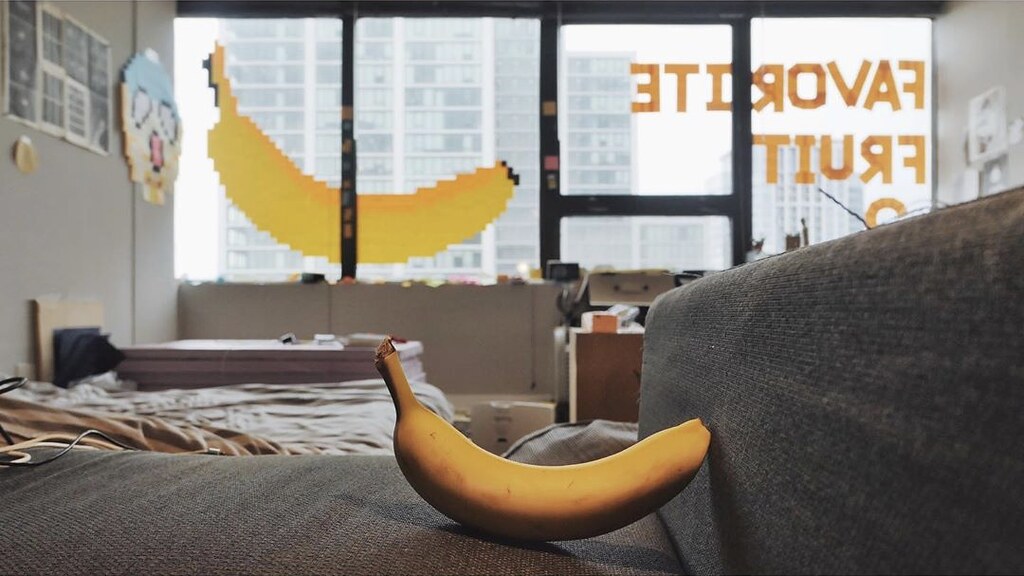
Stay at home, chat on window
Chenyu Lin
School of Art Institute of Chicago, Chicago, IL
Post-it notes, bags, tape, windows, neighbours
changeable size
2020
Lately, due to the quarantine, the entire community of South Chicago has been having a light party every night at 8 o'clock, with each home switching the lights on and off through the window to echo each other. I also used what post-it notes, bags, and tape I had on hand to collage a pixelated Steve Aoki. Since many people think the two of us look alike, I used a celebrity face to say hello to my neighbors across the street, and sort of me say hi to my neighbors.
Since April 6th, I had posted a question or a sentence to chat with my neighbors across the street. In each weekend, I will post a giant image on my window. I see the windows as my canvas and chatting room. Once there was a snowing in the morning, then it disappeared in the afternoon due to the high temperature. At the same time, I posted an Olfa on my windows and removed it piece by piece in the afternoon, while the snow was disappearing.
The newest project on my window is, I posted a giant banana by yellow post-its. Then I have a real banana in my apartment being recorded. For the last 3 days, I followed what has been happened to the real banana, replaced these yellow post-its with black post-its. The whole process has been recorded. I guess there will be only 2 or 3 days, then the banana will be totally black.
For more images and document videos, you can see them from Instagram: neighbourship_ (<a href="https://www.instagram.com/neighbourship_/" rel="noreferrer nofollow">www.instagram.com/neighbourship_/</a>)
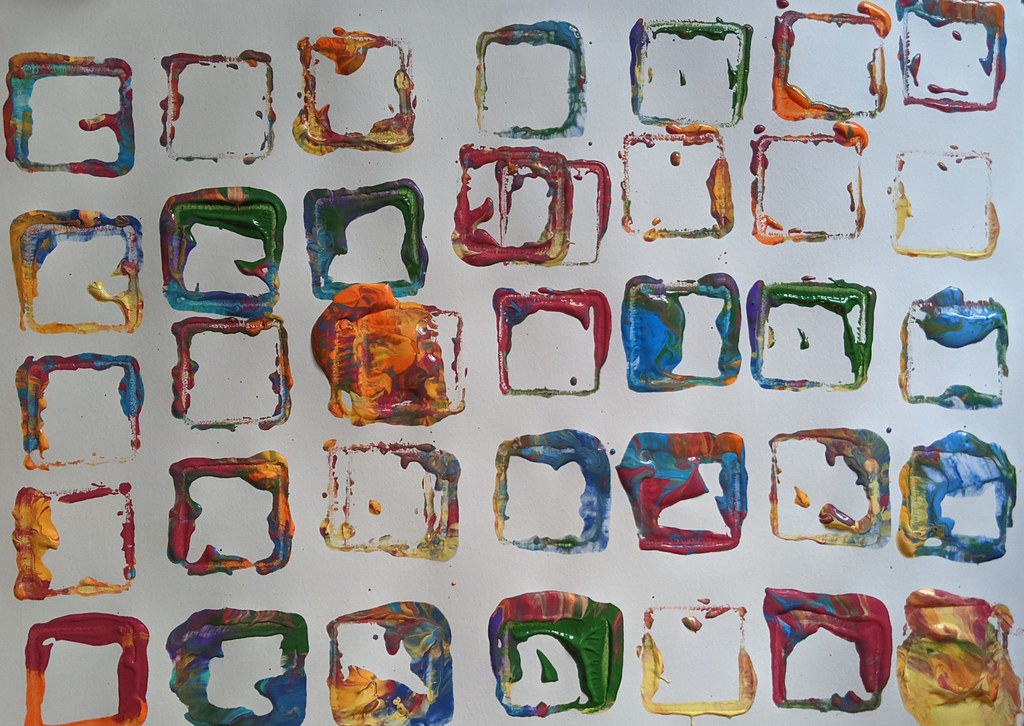
Boxes
Domenic Feola
Penn State University, State College, PA
Acrylic
8.5" x 11"
2020
This piece was created using a stamping technique with found objects from inside the home where I am self-quarantining.

ViralNaut "Goin to Walmart"
Skylar Silva
Humboldt State University Arcata, CA
coffee, ink, Adobe Photoshop
18" x 11"
2020
I was really thrown in a weird loop at the beginning of the COVID outbreak. My creative process slowed and I really had to sit down and work through my thoughts by making art. I used coffee and wine (with watercolor techniques) to make the initial composition, then I used illustrative inking to complete the image. Later I snapped some photos and threw my images into Photoshop and touched up the Images as you saw them. I primarily work with digital art, watercolor, and printmaking techniques.

ViralNaut "Cruisin DownTown"
Skylar Silva
Humboldt State University Arcata, CA
coffee, ink, Adobe Photoshop
11" x 18"
2020
I was really thrown in a weird loop at the beginning of the COVID outbreak. My creative process slowed and I really had to sit down and work through my thoughts by making art. I used coffee and wine (with watercolor techniques) to make the initial composition, then I used illustrative inking to complete the image. Later I snapped some photos and threw my images into Photoshop and touched up the Images as you saw them. I primarily work with digital art, watercolor, and printmaking techniques.

ViralNauts
Skylar Silva
Humboldt State University Arcata, CA
wine, coffee, ink, Adobe Photoshop
18" x 11"
2020
I was really thrown in a weird loop at the beginning of the COVID outbreak. My creative process slowed and I really had to sit down and work through my thoughts by making art. I used coffee and wine (with watercolor techniques) to make the initial composition, then I used illustrative inking to complete the image. Later I snapped some photos and threw my images into Photoshop and touched up the Images as you saw them. I primarily work with digital art, watercolor, and printmaking techniques.

Muse (l)
Neoshia Shockley
Kansas State University Manhattan, KS
charcoal paper, charcoal, pencil
21" x 18"
2020
During this time I wanted to do some self reflecting on my passions. Muse (l) is about the source of inspiration for creative artists, and being in a period of reflection. With this piece I felt connected with myself as I was drawing even though we are stuck inside our homes.

Self-Portrait (In Earrings)
Isabel Arevalo
Carleton College Northfield, MN
intaglio
7.5" x 9"
2020
This trimester, we were unsure if we would be able to have art classes, much less a printmaking class that is so equipment dependent. Our professor has made a printmaking class work for us by shipping plates to each students' quarantine residences, where we were either wood cut or intaglio (hard ground or drypoint) and then we ship back plates. Our professor then does all the printing for us and scans the prints and shares them with the class over our synchronous zoom classes. For this print, a two tone intaglio print done using hard ground, instead of using a direct transfer to line up the tone plates, I (as well as the rest of the class for their respective prints) used tracing paper and transfer paper to duplicate a drawing onto the two plates.

See A Dirty Sea
Carlin Spinney
The Pennsylvania State University in State College, PA
watercolor, magazine, charcoal, acrylic
8" x 6"
2020
I really wanted to exaggerate the process of trash entering the ocean. We destroy the world of these innocent animals in order to keep our world perfect. The trash is a threat to their everyday existence. I struggled deciding when the pieces were finished, and it was challenging to find things that related to all three pieces. They are all related to the trash in the ocean, but they are also three kind of separate topics within the topic.

See A Dirty Sea (2)
Carlin Spinney
The Pennsylvania State University in State College, PA
watercolor, magazine, charcoal, acrylic
8" x 6"
2020
I really wanted to exaggerate the process of trash entering the ocean. We destroy the world of these innocent animals in order to keep our world perfect. The trash is a threat to their everyday existence. I struggled deciding when the pieces were finished, and it was challenging to find things that related to all three pieces. They are all related to the trash in the ocean, but they are also three kind of separate topics within the topic.

See A Dirty Sea (3)
Carlin Spinney
The Pennsylvania State University in State College, PA
watercolor, magazine, charcoal, acrylic
8" x 6"
2020
I really wanted to exaggerate the process of trash entering the ocean. We destroy the world of these innocent animals in order to keep our world perfect. The trash is a threat to their everyday existence. I struggled deciding when the pieces were finished, and it was challenging to find things that related to all three pieces. They are all related to the trash in the ocean, but they are also three kind of separate topics within the topic.
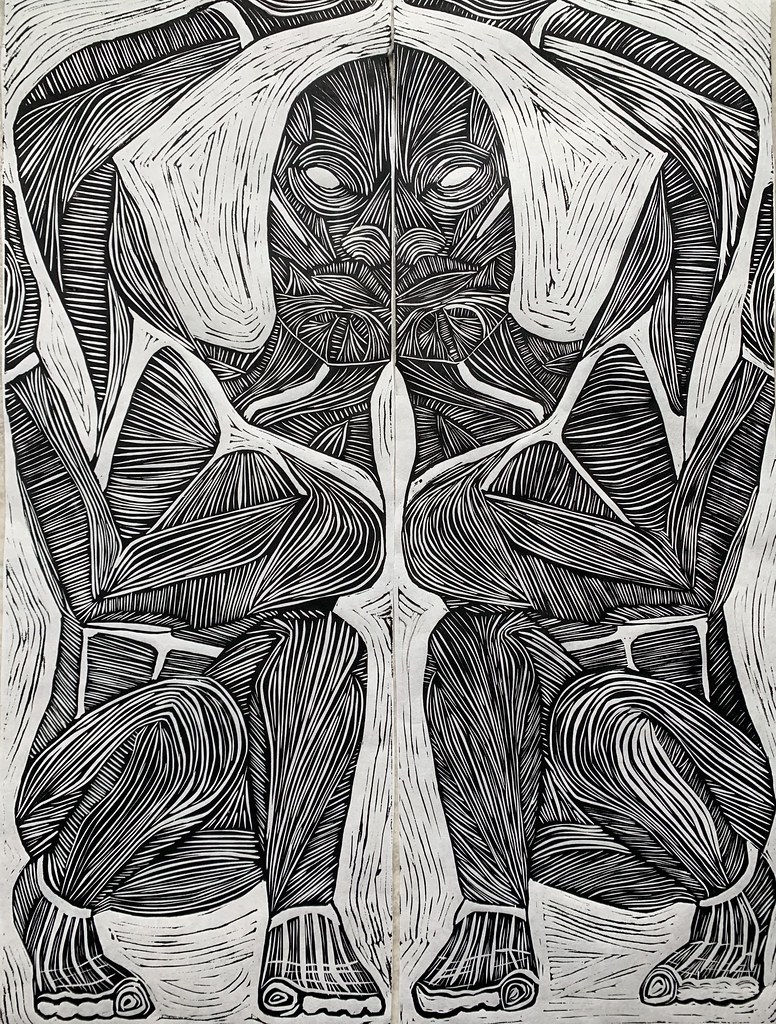
Dysfunction
Kendall Gott
Western Kentucky University, Bowling Green, KY
linocut
24''x 18''
2020
As a student, trying to carve with my family around is tough. As much fun as it is to do art around family, it's equally as difficult to focus. Then actually printing was tough, trying to find something that wouldn't tear the paper and get a good transfer. I ended up using a metal measuring cup!

Book Beetle
Ashley DeVan
Kennesaw State University, Kennesaw GA
acrylic paint
6" x 4.25"
2020
I chose to create my print using an old unused book. After coming up with my design for the print and planning out the different layers I started by sketching the first layer onto a page of the book. Then I used an x-acto knife to cut out the areas and shapes that I wanted to print. After this, using the stencil I had just created I continued to cut through the pages below to create several copies of the stencil to use if need be. Using the spine of the book to assist in registering, I placed the paper I am printing behind the stencil page. I used masking tape to hold the paper in place. Lacking any color ink I used acrylic paint instead. In place of a squeegee or rubber brayer I used a foam brayer/roller to push the paint through the stencil onto the paper. Once a solid layer was created I undid the tape from the paper and set it aside to dry. I then repeated these steps for each layer until finished. Depending on the amount of paint used, thin areas of the stencil would sometimes tear or seep through the back on the edges of the stencil. If this occurred I would simply move onto using the next stencil copy I had made of that layer. I also used tape to reinforce some parts that I thought were especially thin and was worried they may tear, such as in my last layer. Despite this I feel it held up pretty well. The only other challenge was registration which could easily be solved with a more consistent method, such as using transfer paper to more accurately transfer my design for each layer before carving.

Self Portrait
Tyrone Quigley
Carleton College, Northfield, MN
intaglio
10"x8"
2020
Professor Fred Hagstrom taught two-color printing without a press, using transfer paper to register a traced image on two plates. Although more of a hassle then the corresponding studio process, it ultimately functioned similarly. I ended up just using the transfer for a outline of this self portrait and working directly from a mirror for detail, focusing on the infinite contours of the face. Tone was limited to the shirt.

Curb Stomp
Grace Ritchie
Maryland Institute College of Art, Baltimore, MD
cross stitch
4.5" x 3.5"
2020
Without access to our studio and therefore, all of our printmaking equipment, it felt impossible to imagine what work I could make for my studio classes that would feel worthwhile. I decided to take this as an opportunity to try something I'd always wanted to do: cross stitch. At first, I thought it was hilarious that my Intaglio professor was letting me cross stitch for a printmaking project but as I worked, I found many similarities between the two processes. Both begin with a finished drawing and then move to a multi-step translation that distances the image from the artist's direct hand. For my cross stitch, I created my own gridded pattern from my sketch and followed that pattern while I stitched. Both processes also involve repetitive steps to reach completion. I found the same comfort in the act of counting squares and stitching x's as I did in etching and inking an intaglio plate.

Kağıt Kizi(Paper Girl)
Dilara Miller
University of Colorado Boulder, Boulder, CO
linoleum relief print, Nori pasted onto a monotype
10" x 8"
2020
Since working from home I’ve found that there some loopholes to create work in a similar manner to how it would have been in the studio. When I first started printing relief prints I found that it was difficult to tell how much pressure would transfer the carving uniformly. Each print would turn out faint or unevenly printed. I realized that instead of printing on thicker papers I'd try printing on thin handmade Japanese papers. When using a spoon, you could now see through the paper and notice if some parts of the print needed more pressure. I also discovered gelli plates during this time and how it was easy to manipulate the plate to act as if you were monotype printing with plexiglass through a press. Through layering stencils and textures I was able to create the background for the cut out dresses. Though printing at home takes longer, I’ve found that it feels more nurture-full, since creating these prints is more labor intensive than it would have been in the studio I find that the prints mean a bit more to me since my hands are more involved.

Masked Wildcat
Margaret Perez
University of Mississippi, Oxford, MS
copper etching
6.5" x 4"
2020
Challenges of getting a good impression on a very old well loved proof press. Acid challenges during the etching process.

Lake Rochester
Libby Marx
Illinois State University, Normal IL
pen and ink drawing
12" x 9"

March 2020
Nicole Arnold
Illinois State University, Normal, IL
woodcut
4 impressions 6" x 8" each
2020
Each print was carved and hand printed at home during the 2020 Covid - 19 stay home orders.

Conversation and the Self
Ina Kaur
Srishti Institute of Art, Design and Technology, Bangalore, India
print bricolage and graphite drawing on handmade paper
15" diameter
2020
The work started as a reflection on loss - loss of connection with people, places, nature, and loss of one’s connection to themselves. This work provided a space to pause and remember this loss, but also a space to shift one’s perception and develop new perspectives and possibilities. It allows to nurture past experiences and memories, and a space to contemplate and reinvent.
The work utilizes techniques of collages and bricolage of remnants of old and test prints with basis mark-making in the absence of print facilities and resources. The work intends to continue the dialogue of what making impression/print or leaving a mark means? It provides the opportunity to reimagine by combining, rearranging, reusing, and reorganizing a previous closed set of materials and methods to re-contextualize and built new meanings.

Sweet Beetle
Kate Duffy
Virginia Commonwealth University, Richmond, VA
mix media screenprint, linocut, & etching collage
30" x 22"
2020
When the etching studio closed due to COVID-19, I had to pivot the plan just like everyone else. I had been learning the etching process and working on two plates before the shutdown. Neither plate was ready for edition printing, but I had plenty of trial runs to repurpose. I was lucky to have a couple of screens with stencils burned from a previous project and a couple of blocks of linoleum.
Collectively, we are experiencing a lot of loss. Most devastating the loss of life in tremendous numbers. I had already lost several people in my own life since the fall semester. Social distancing at home during the pandemic created the time and space to grieve all of the loss. I decided to work through some of the grief by paying tribute with the assemblage of memorial wreaths. The first one is for my cat, Beetle. The sweetest little being.

Terry Turtle
Kate Duffy
Virginia Commonwealth University, Richmond, VA
mix media screenprint, linocut, & etching collage
30" x 22"
2020
Description of process: When the etching studio closed due to COVID-19, I had to pivot the plan just like everyone else. I had been learning the etching process and working on two plates before the shutdown. Neither plate was ready for edition printing, but I had plenty of trial runs to repurpose. I was lucky to have a couple of screens with stencils burned from a previous project and a couple of blocks of linoleum.
Collectively, we are experiencing a lot of loss. Most devastating the loss of life in tremendous numbers. I had already lost several people in my own life since the fall semester. Social distancing at home during the pandemic created the time and space to grieve all of the loss. I decided to work through some of the grief by paying tribute with the assemblage of memorial wreaths. This one is for my friend, Terry Turtle. Terry was an artist, musician, and visionary.

PRELUDUIM OP.7
Elżbieta Gibulska
Bialystok University of Technology, Bialystok, Poland
monotype
66 cm x 46 cm
2020
I think that your exhibition is amazing idea! Thank you for this possibility.

PRELUDIUM OP.3
Elżbieta Gibulska
Bialystok University of Technology, Bialystok, Poland
monotype
66 cm x 46 cm
2020
I think that your exhibition is amazing idea! Thank you for this possibility.

untitled
Rhea Nowak
SUNY Oneonta, Oneonta NY
woodcut
7" x 7"
2020
I am very lucky to have a little table top press at home. I am limited by time and mental focus as I work with my art students online. My process was one of exploration of color overlays working with both reduction cuts and masks in a small series of monoprint woodcuts printed from one block. I wish I had the focus to be able to title this series, but it is about flow and not-knowing.
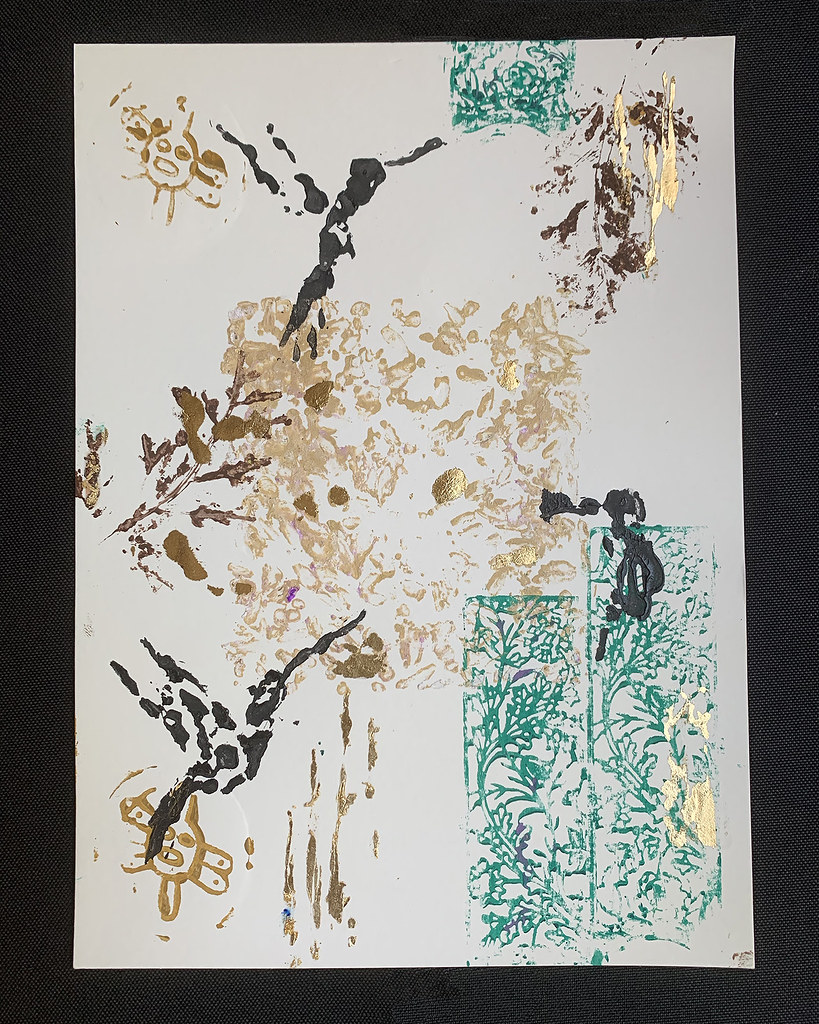
Hummingbirds
Juliebeth Delgado
Kennesaw State University, Kennesaw, GA
mixed media print
10" x 8"
For my Lockdown prints, I decided to use anything that I had at home that had texture. I wanted to do some experimental monoprints with birdseed bocks, stencils, clay stamps, plants, and wooden stencils. Once I finished the monoprint, I created a hummingbird stencil on cardboard and use hot glue to make it more three dimensional. Since I didn't have a press to print it on paper, I used a rolling pin. It was challenging at first because I had to play around with how much pressure I had to put on it. When I was done, I put some gold foil on top to add a glimmer effect to it.

House on the Hill
Livie Wang
Kennesaw State University, Kennesaw, GA
reductive relief on linoleum
2" x 3"
2020
It was my first attempt at a reductive relief and that alone presented many challenges. I had 7 different runs and keeping track of all of the layers was difficult. In terms of materials, I used what I had which is why I used such a small linoleum block. I also used scraps of stonehenge paper that I had previously discarded from past print projects that required the resizing of my paper. In this time of lock down I am very glad that I held on to the discarded paper. I didn't have a barren or a press so I used wooden spoons and spatulas for printing. I had a limited set of inks so I had to spend lots of time mixing and experimenting with the colors I had. This has led me to a better understanding of the inks and colors I have and how opaque or translucent certain colors are. Now for future prints I have an idea of how to create certain effects and looks and how I can mix in different bases or colors to change opacity. Gold leafing the print also took some time and effort to get just right. My print, 'House on the Hill,' took a lot of patience and trial and error however I am happy with the results. I hope that whoever views it will receive a sense of tranquility and happiness during this time of lockdown.
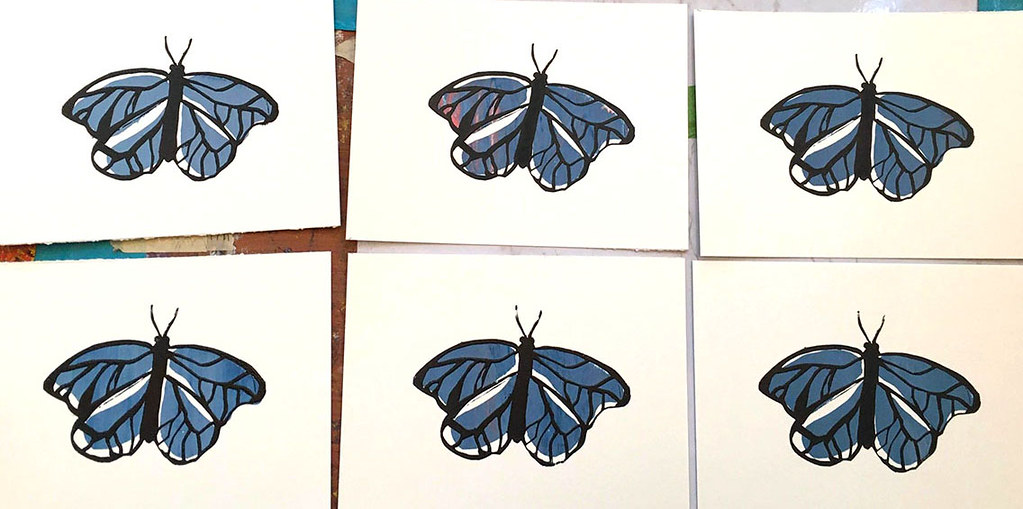
blue butterflies
Lily Wieleba
Guilford College, Greensboro, NC
screen printing
6 impressions 4.5" x 6"
2020
My biggest challenge so far has been changing my preferred focus of etching to screen printing and learning how to print while only using contact paper. It has been a huge learning curve for me to learn proper registration as well as how to make a simple image that I'm happy with. For my butterflies, the most difficult part was creating the black lines for the wings. I had to make a key for where each piece would go to create my desired pattern on the wings. My butterflies are the most ambitious and rewarding piece I have done during quarantine so far and I have learned a lot throughout my constant trial and error of making a print I am proud of.

CHANCE ENCOUNTER
Jackson Taylor
University of Iowa, Iowa City, IA
intaglio
16" x 24"
2020
This is a two-plate etching completed on steel. The print was made during limited access to printmaking facilities, and most of the acid work was completed in a basement in Iowa City as a result. The plate size is 16" x 24" on a full sheet of German Etching paper. The print was inked and printed in an attic in Iowa City. The work deals with moral and spiritual decay in the American South.
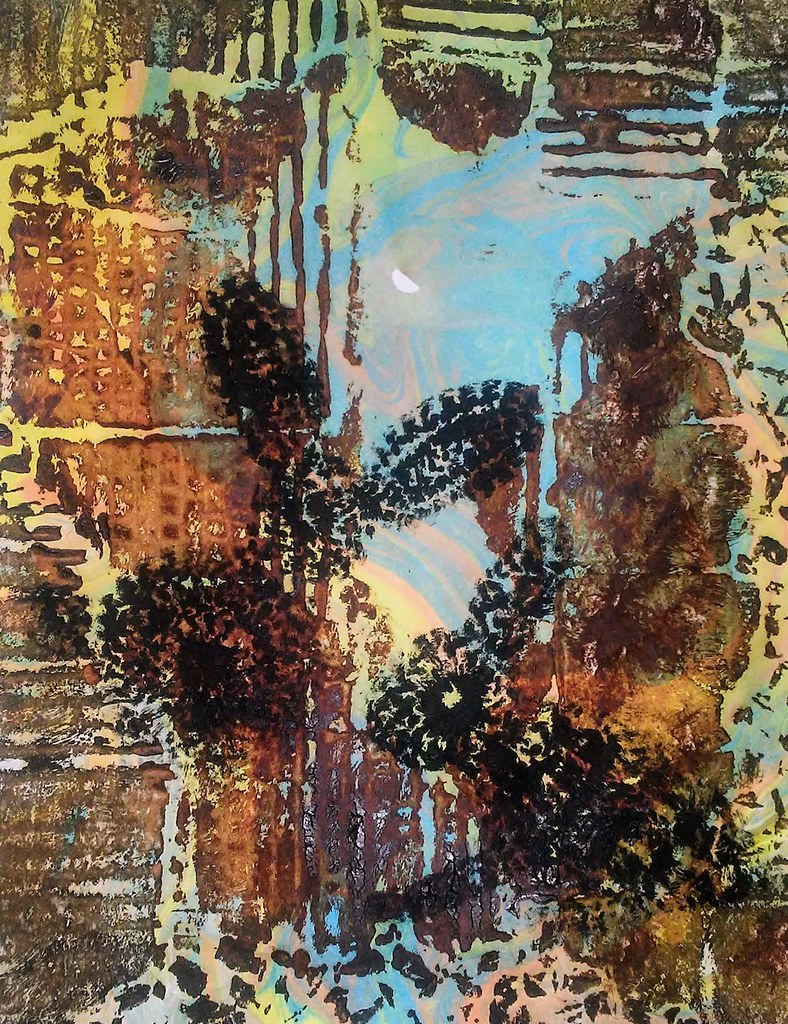
Every Bunny Stay Home
Virginia Moore
Kennesaw State University, Kennesaw, GA
collagraph & monoprint on marbled paper
11" x 8.5"
2020
Lock down during Covid 19 pandemic sure has been a challenge but at the same time it has opened me up to different ways to print. My love of fiber arts (crochet) has been implemented into my prints. I crocheted flowers, leaf, and bunny appliques for printing. I have many types of paper to print on that included: handmade with/ without inclusions, handmade eco paper, and cardstock. All worked very well in my processes.
Everything I printed was with my hands, fingers, and a wooden block covered with felt. All hand printed with no traditional press involved. I love how the texture of my stitches have imprinted on the paper.
To replace traditional printmaking inks, I used oil based paints thinned lightly with homemade medium from Damar Crystals and turpentine. I dabbed the paint onto the appliques and used hand pressure to print on the paper.

Tending to the Heart
Brooke Leland
University of Wisconsin-Madison, Madison, WI
colored pencil on toned pastel paper
12" x 9"
2020
After my advanced etching class was banned from the studio, I had to leave many projects unfinished. With no press or acid, I set to work on re-imagining my sketches of scissor-birds and heart-branches in colored pencil on paper. This was the first time I have used the medium since I was a freshman in college. I'm excited to use what I learned with color layering in future CMYK etchings.

QD #6
Taro Takizawa
PrattMWP (Munson Williams Proctor Arts Institute), Utica, NY
ink on paper
14" x 10"
2020
With no studio access, I am reduced to painting and drawing at my dining room. The process is simple though this is basically the same application method I use in my recent stone lithographs.

Grandmother's Doily
Maddi Bryce Smith
Kennesaw State University, Kennesaw, GA
salt dough relief print
14" x 11"
2020
While in quarantine, my family and I have been taking up baking, so I thought it would be fun to incorporate into a print. Using salt dough, I am able to make my own plates to print off of since they harden completely. The recipe I used is 1 cup of plain flour, ½ cup of salt, and ½ cup of warm water. These ingredients are all very accessible, and I was easily able to spare these small quantities of them. Originally, I was planning to carve into the plates like relief blocks with toothpicks. However, while stuck at home, we have also been cleaning out closets and found some beautiful vintage handmade doilies from my grandparents and great-grandparents. I experimented with pressing them into the salt dough with a rolling pin to get a really unique texture that can be inked and printed. The result is the holes and empty spaces of the doilies if printed as a relief. Since they can be washed after pressing into the dough, there was no harm done to the doilies. After baking for two hours at 180 degrees Fahrenheit, I sealed the plates with a polyurethane spray. I was then able to print using acrylic paint as ink and spooning to burnish. I played around with colors and combining paints in different ways. The result is a way to preserve the doilies as a print and honor my grandparents and great-grandparents. This print was completed April 19, 2020.
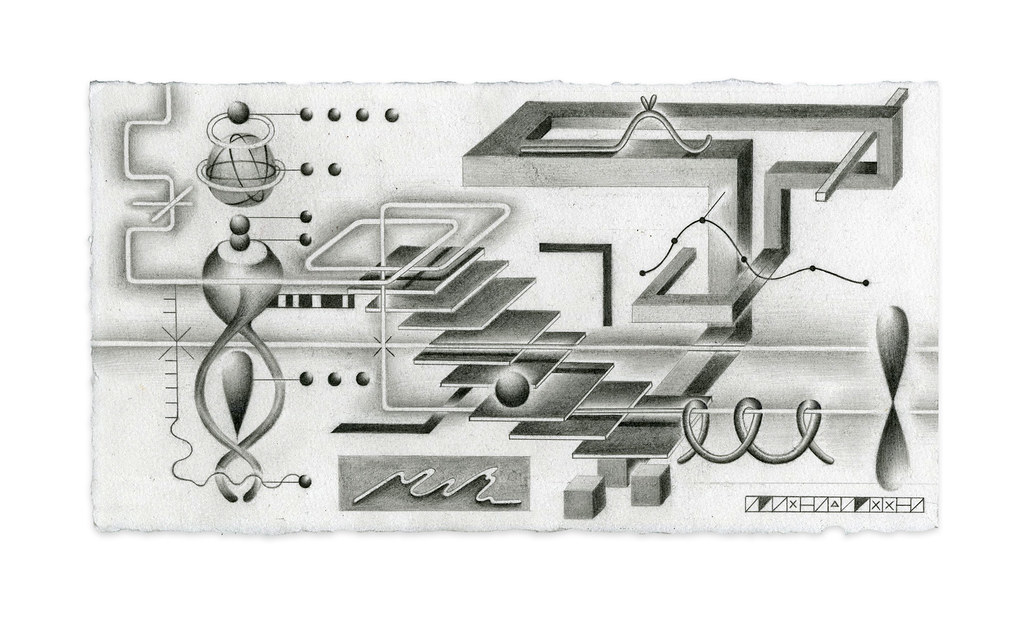
Neurosphere
Erika Shiba
Illinois State University, Normal, IL
graphite on paper
6.25" x 12"
2020

"Street Trash: VerticalXO" (front view)
Tracy Featherstone
Miami University, Oxford, OH
artist book - silkscreen, collage, graphite on paper
sizes variable: 18" x 20" open
2020
I started a series of folded silkscreen prints before COVID based on street trash. They are interactive prints made to be viewed as a sort of artist book. I was unable to complete with planned silkscreen approach due to studio shutdown. Instead I used mixed media and collaged parts of older drawings and prints to finish the series. The material from multiple sources actually gave the prints a more layered/weather looked which goes well with the initial inspiration of found street detritus. You can see a short video clip of the print being opened and flipped here. <a href="https://youtu.be/HPpHxtIXrso" rel="noreferrer nofollow">youtu.be/HPpHxtIXrso</a>

Harmony
Lisa Jungmin Lee
Tyler school of Art, Temple University, Philadelphia, PA
stencil on etching
4.5" x 3.5"
2020
I did stencil with speedball ink on top of my etching print I made in February. This original etching print is 13 x 18 size, and I cropped them all to make collage with colors. I wanted to see how fine line works go with vivid colors- harmony and balance of simple lines and distinguishable colors.

Double Bunz
Sara Hess
University of Georgia, Athens, GA
collaged printed matter
14" x 14"
2020
This collage/assemblage is the product of vestiges of printed material and my walks taken around Athens, Georgia during the quarantine. My current at-home studio practice primarily consists of collaging. I have adapted to use the resources most readily available to me, such as household materials like tape, found objects and debris from outside, and leftover chunks of monotypes, lithographs, and etchings. I think in terms of printmaking by layering both imagery and material. This process naturally lends itself to intuitive play to yield wonky yet familiar compositions.

The Kwquad
Branstarr Sihanath
Illinois State University, Normal, IL
oil pastels, chalk pastels, graphite, ink, magazine clippings
13" x 17"
"The Kwquad" was in response to the announcement of all courses being moved online for the rest of the semester. As a student who had their senior year cut short, I was not ready to part with the campus. The work uses frottage to capture textures from specific locations on ISU's quad. Each location relates to where I have chosen to sit, draw, or do homework within the past four years. There are comments made by some of these textures that allow this piece to become journal-like as it shares my personal thoughts and memories.

Porter II
Shivam Pawar
University of Alabama, Tuscaloosa, AL
etching
9" x 15"
2020

Scream
Upneet Kaur Mair
University of Alabama, Tuscaloosa AL
etching (aquatint)
18" x 12"
2020
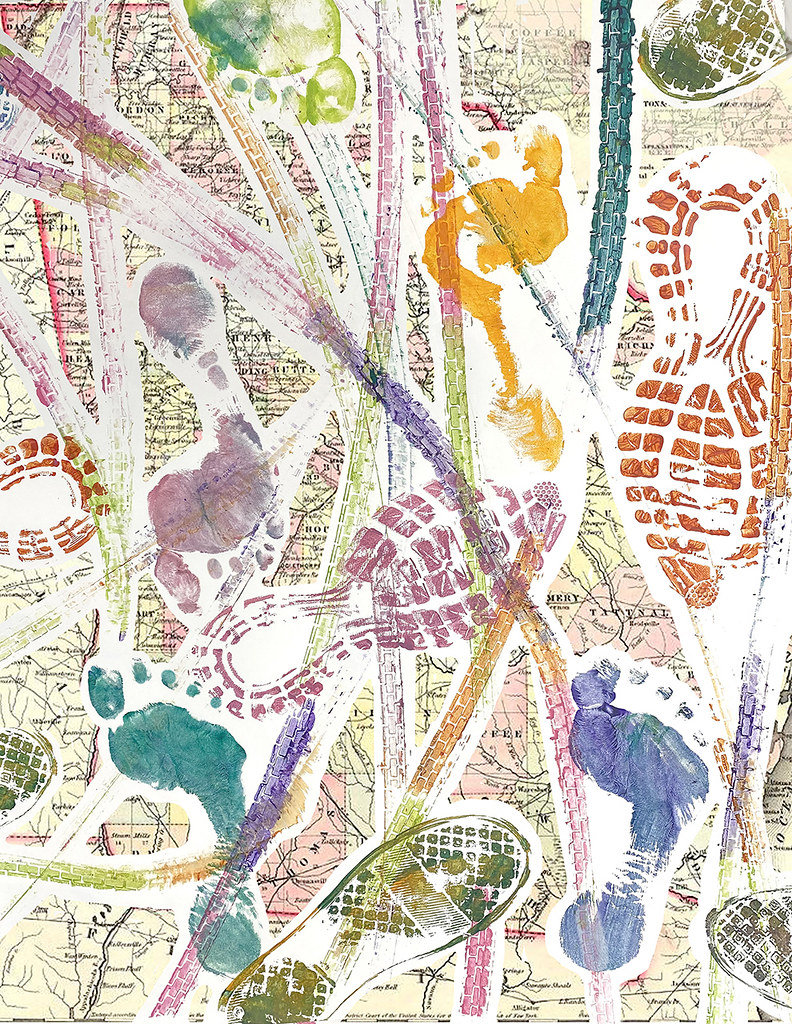
Travel 3
Valerie Dibble
Kennesaw State University, Kennesaw, GA
bike tire, running shoe and food print with chine colle using a map
30" 20"
2020
I took water based paint and ran my bike tire through it and printed, then walked through it with my shoes and then took them off and used my foot as a matrix. Then I used a cut up map as chine colle of sorts.

Pup Tail and Paw Prints
Valerie Dibble
Kennesaw State University, Kennesaw, GA
paint on paper and stencil print
30" 20"
2020
I got my dogs to walk across paper with their paws inked with non touch food safe ink and had them sit with their tails inked while they happily licked peanut butter off a spoon and made tail wag prints. Then I stencil printed their portrait on top with more paw print stamping. No animals were hurt in this process!!

Julia Edelmann_90870074_img_1025
Julia Edelmann
Pennsylvania State University
acrylic paint
36" x 24"
2020
For this print, I used letter stickers stuck onto an earring box, and stamped them with acrylic paint. The words are printed backwards because of this, which I like because it makes it harder to read at first glance. The repetition remind of the game of duck duck goose and playing it as a child, and I can imagine running around the circle with my childhood friends. The process was challenging because I had to hand paint the stamp almost every other time so that the words would actually print, so it was extremely time consuming since the piece is so large.

I'm Tide
Branstarr Sihanath
Illinois State University, Normal, IL
watercolor, acrylic, ink, and a page from a planner on mixed-media paper
10" x 7"
2020
Before the rise of COVID-19 cases, I was exploring my personal daily schedule and the idea of needing the days to be structured. The series of work was interrupted by the shelter-in-place; I could no longer make references to my original routines because it is now non-existent. This piece acts as a response to the shelter-in-place and how the interruption has caused the feeling of disorganization, irritation, and fatigue.

Juicy
Tess Murphy
Illinois State University, Normal, IL
makeup pochoir
3” x 3”
2020
I drew the design and then reductively cut it into a stencil. Then using eyeshadow I pushed the pigment into the areas I cut.

Lost in the Forest
Matthew Brunetti
The Pennsylvania State University, State College, PA
acrylic
21" x 12"
2020
The process for this piece was experimentation from start to finish. I first attempted watered down acrylic and that lost all resemblance of shape once it met the canvas. Plants when used as stamping tools are surprisingly unpredictable and exciting. The lack of consistency made each attempt interesting when making something new especially since I own zero printmaking tools. All of them got left behind at school along with many others.
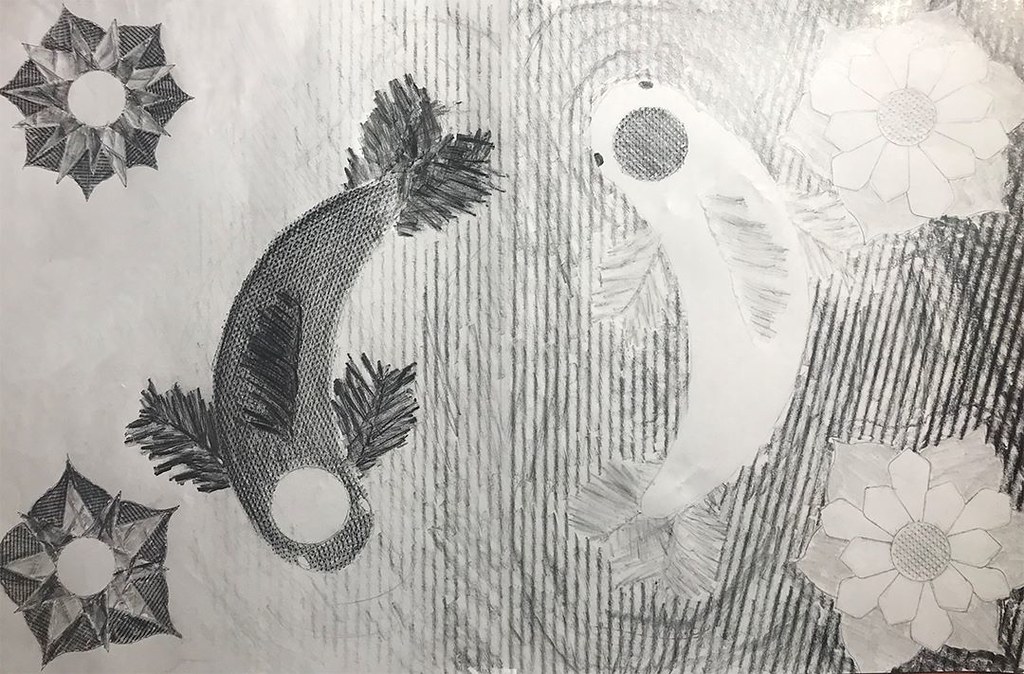
Perfect Balance
Robert Shoemaker
The Pennsylvania State University, State College, PA
graphite pencil frottage
8.5" x 11"
2020
I wanted to create a piece that was completed when two separate images where put together. At first I wanted to use tracer paper to layer the images on top of each other but I was unable to bring out the white as much and fill all of one page. I decided to use standard printer paper and the main idea of balance. This idea came from the all the time I spend at home now, I find it hard to create that sense of balance in life when I can no longer go out and do different activities with everyone. These pieces were created using frottage printing methods and used many common household objects from coins to bowls to cardboard to a comb. I also used leaves from around my building.

Rip Tip
Alexis Coffel
Kansas State University, Manhattan Ks
ink and watercolor
11.5" x 7.5"
2020
I made a trace monotype and then went over it with watercolor

Veiled 1-2
Liam de Freese
Maryland Institute College of Art, Baltimore, MD
photography
1199 x 338 pixels
2020
Since we do not have any studio access anymore, my Intaglio professor encouraged us to think of printmaking in a broader sense: anything that has a matrix, a transfer method, and a canvas. I decided to use light and shadow to create a series of prints- inspired by the thought of a varied edition. I first tried scratching mylar with my etching tools, however the result were too fuzzy. I then cut out a silhouette, which worked much better. I took the photos in the basement. As a light source I built a projector consisting of several lamps in a cardboard cone that is covered with aluminium foil on the inside and that has a magnifying glass attached to the end. My model is my room mate Blake. We talked about the implications of me projecting an image onto her face, obscuring her identity. We think of the piece as an allegory to the beauty standards that society projects onto women. In a broader sense I wanted to talk about gender expectations. As a trans person the stretch between the desire to pass as the gender I identify with and the desire to express myself in my own way is a struggle I face on a daily basis.

"Southwest Lady"
Meli Nava
School of the Art Institute of Chicago, Chicago, IL
screenprint, ink
9.75" x 12.5"
2020
With this work, I wanted to allow my fantasy to roam around given that due to this pandemic, I have lost my BFA show, graduation, and access to a private undergraduate studio space. Having to flee Chicago to my hometown Phoenix, AZ, I began to think about imagining a version of myself that was allowed to exist wherever and however she pleased. I treated this work as a form of manifestation for not only a different situation, but of how I want to be seen. I believe that trying to find an idealized place within ourselves is important right now.
Primarily a lithographer, I am not too proficient at screen printing. Though, once I was in a space with no resources, I saw screen printing as fairly doable medium to attempt at home. While, I did not have an exposure unit, or drawing fluid for that matter, I began to simply brush on screen filler directly onto the screen carefully with a drawn stencil. I managed to get a clean enough stencil and began to print. I managed to set my screen onto a folding table with some clamps and pulled with my rather small squeegee. To get the detail I wanted in the face, I ended up using a marker as I did not want to risk it with the drawing fluid
The most immediate challenges were definitely the shrapnels of my images and inevitable patches of ink coming through areas in the screen where I did not coat with enough screen filler as I did not have scoopcoater. Registration was another ordeal as clamps had to be readjusted every print, but was definitely a good exercise of registering. Another challenge was not having the access to a spray booth and power washer. This led to the cleaning of a screen being rather difficult, but I managed for now. Though, I had to come up with makeshift ways to screen print, different to what I had been used to, I felt the experience as very humbling and exciting to see how I could create after graduating from an institution with as many resources as it does.
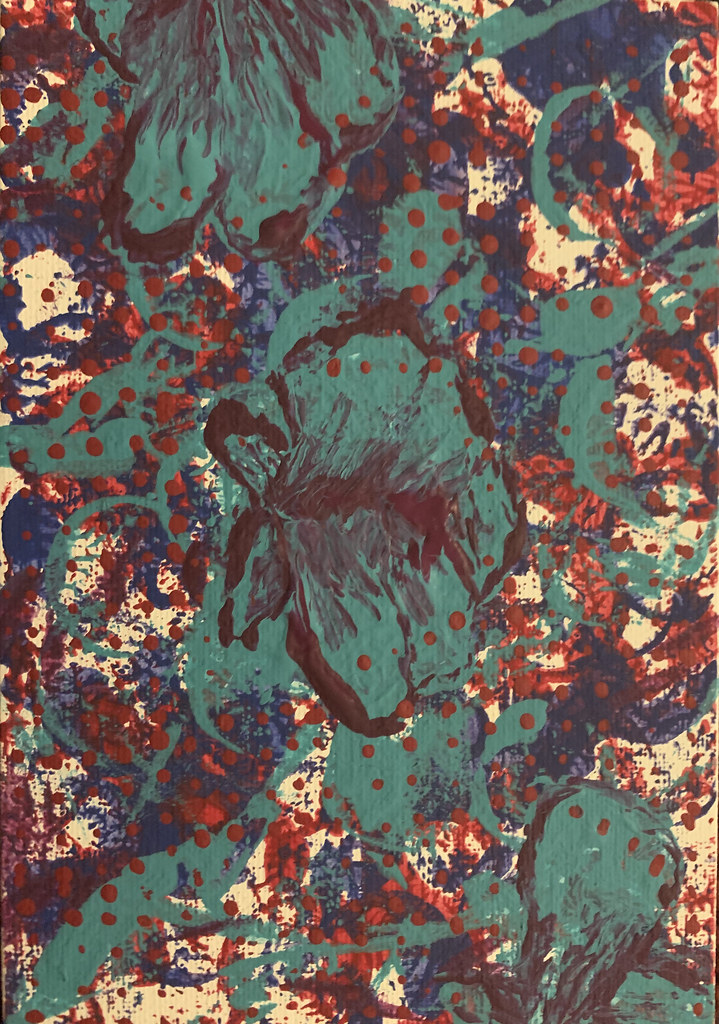
untitled
Jess Rodriguez
Pennsylvania State University, State College, PA
paint
7" x 5"
2020
Used a water bottle to create dots then used utensils to add details like flowers.
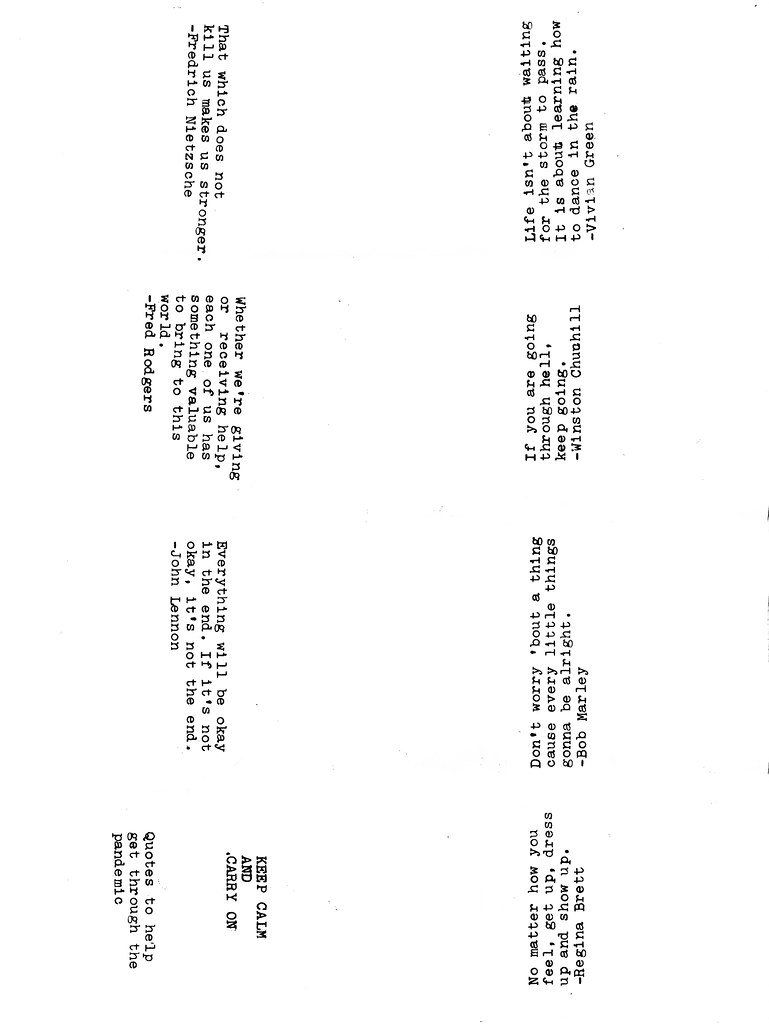
Rachel Singel_90870074_zine_singel
Rachel Singel
University of Louisville
typewriter
11" x 8.5"
2020
I usually use my typewriter to keep attendance in class every day: the students type in their name and the time they arrive. But now, I decided to use the typewriter to make a small zine that people can fold and have on hand as a source of inspiration to help them get through the day during this time of uncertainty.

Internet Dreams and Beaches I Wish I Was On
Sophie Rogers
Carleton College, Northfield, MN
mail art--transparencies, sharpie, typewritten text, white out, gauche
4" x 5" plus envelop
For the past semester I've been screen printing these little drawings I do on blank transparencies and using letterpress in my ceramics. Away from both the print shop and the ceramics studio, I've been going back to designing things for later and keeping in touch with the people I get to be around in those studios. This is a piece of mailart to my friend thinking about why we're studio majors and not web designers with a picture I found at an estate sale of a family at the beach.

2020 face of isolation
Quinn Russo
Maryland Institute College of Art, Baltimore, MD
ball point pen on tracing paper
11" x 8.5"
2020
Looking for print adjacent methods of creating iterations of images, I've spent some time constructing compositions from graphite, and redrawing them translating them into color. Using color ball point pen with tracing paper the final constructed image is made with line and tonal variations.

Motionless Statue Vanishing Ripples
Jenny Wu
Maryland Institute College of Art, Baltimore, MD
Stabilo drawing on Tru-grain with digital coloring
18.5" x 52"
2020
I initially intended on making this triptych using positive plate lithography. The images are first drawn on Tru-grain and would subsequently be exposed on plates. I printed the first layer of the left image. Yet, due to the closure of school we aren't able to use the studio anymore. Therefore, I decided to finish the project as drawings and digitally manipulate colors.

Frottage Chaos
Francesca Travagli
The Pennsylvania State University, State College, PA
mixed media on paper
11" x 8.5"
2020
I used mostly graphite on printer paper, as this is my first time doing frottage exploration. I was really interested in shapes and organization with some mess. In a way, I used my colors, both bright and dark to give some balance of mysteries yet a welcoming invitation.
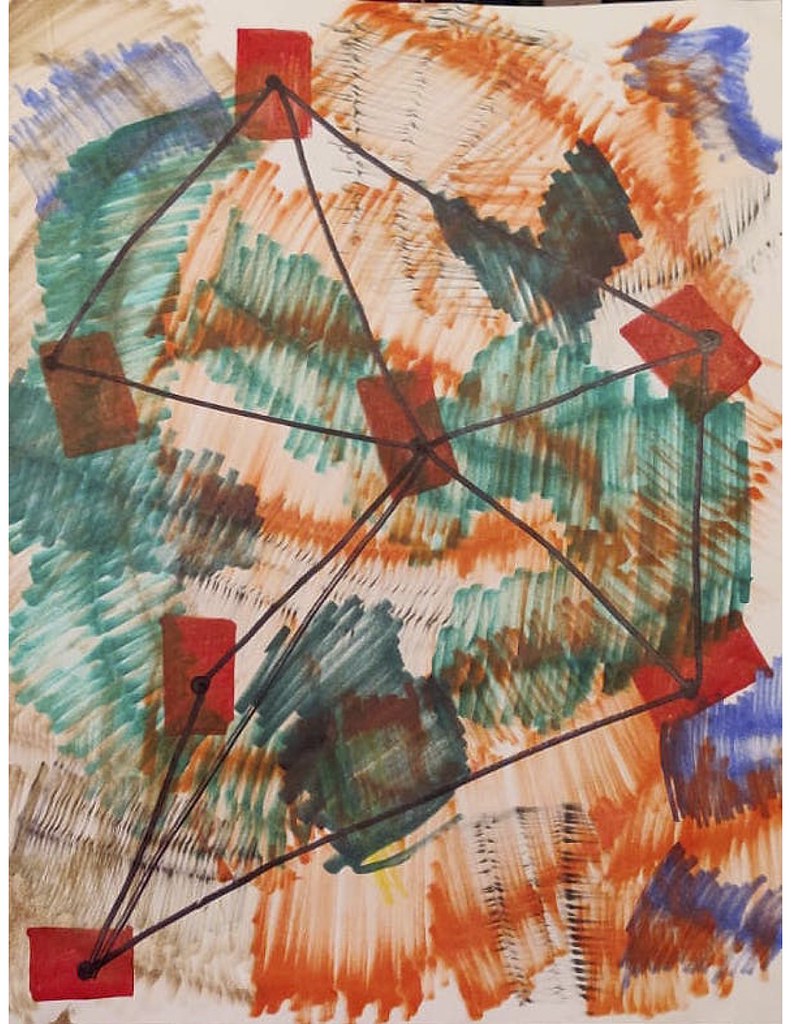
Frottage Chaos Part 2
Francesca Travagli
Pennsylvania State University, State College, PA
mixed media on paper
11" x 8.5"
2020
This the second piece in my series, while there are still some bright colors there is an element of mysteries and invitation. The piece is also on printer paper like the previous submission, Frottage Chaos.

Corona virus protective gear
Manuel Hernandez
Indiana University Southeast New Albany, IN
acrylic paint on unstretched canvas
4" x 3"
2020
I have made paintings focusing on the attire people wear to be out in public during the pandemic. this is one of the many paintings I have done. for this one it depicts a small child in a market not unlike the ones where the virus was rumored to have begun. due to my limited resources I have had to make my paintings smaller than usual and have had to learn to use only small brushes. I can no longer use the tools at school to stretch canvas so the surface has been loose which means loss of detail. I attached my surface to a clipboard and that is where I get a sort of hard base to work on.
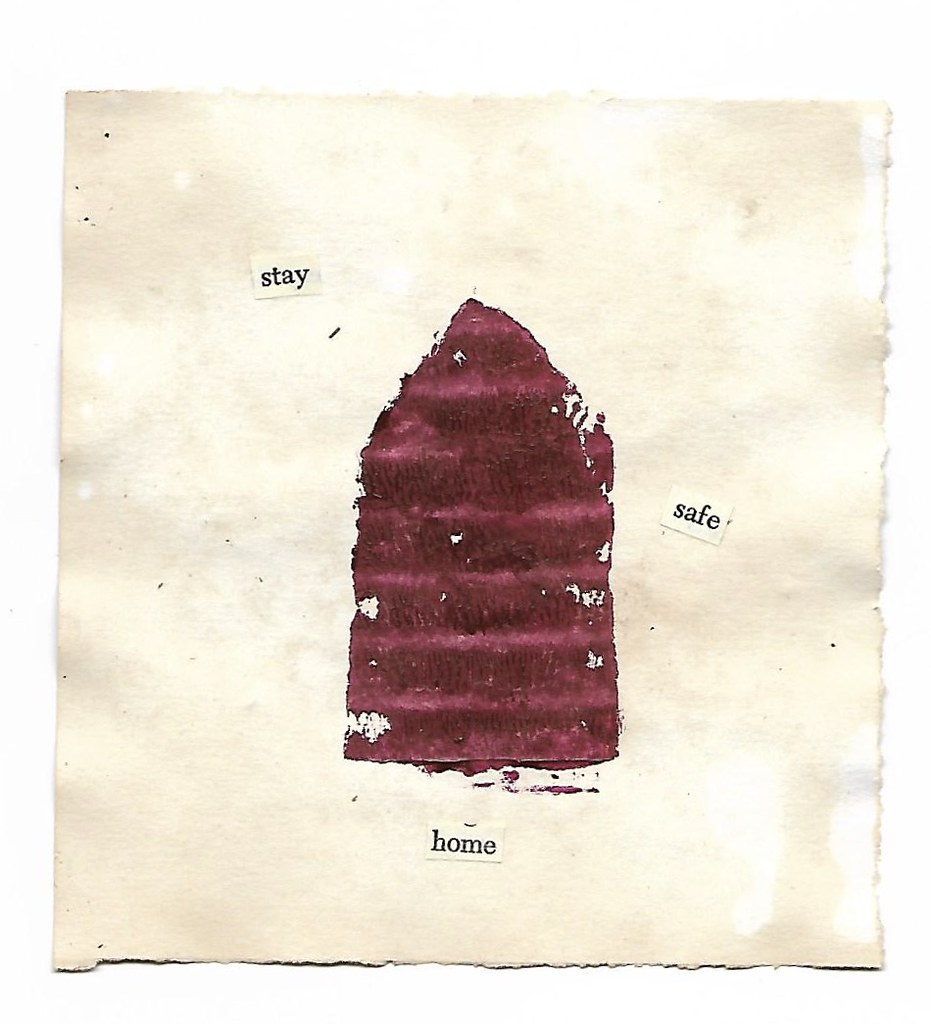
Stay
Julia Wozny
Central Michigan University, Mount Pleasant, MI
mixed media
4.5" x 4"
2020
I started by cutting pieces of cardboard into house-like shapes. I used acrylic paint and pressed it onto tea-stained paper by hand to print in a relief style. Then I added text that I cut out of pages from a book.
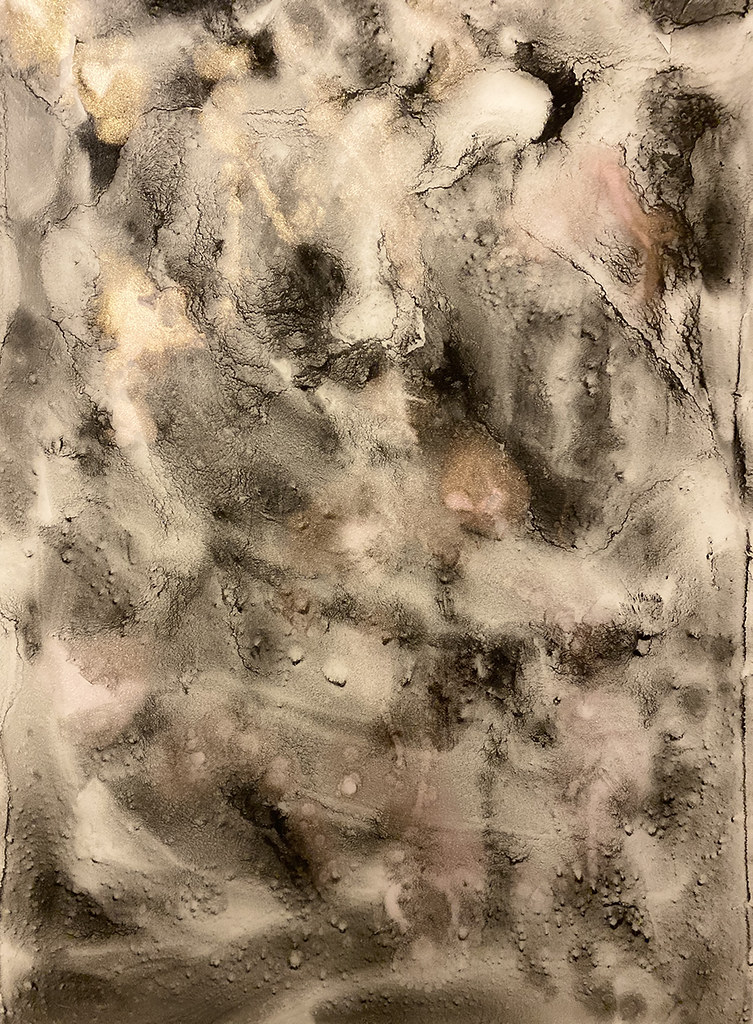
The Inside
Kristin Sarette
Utah State University, Logan, UT
toner wash and opalescent dusting on velvetone
25" x 15"
I wanted to perfect my toner washes to shoot to photolithography plates during this time. I was also experimenting with getting opalescent dusting to reticulate using water and photoflo. This is the result of the two merging.

Corona Plaid #3
Mike Sonnichsen
University of Idaho, Moscow, ID
typewriter text in 4 colors (OCR-B printwheel)
4.5" x 4.5"
2020
I love letterpress, systems, and the indirect nature of printmaking. While typewriter art may be a strange cousin to letterpress, it requires its own sort of rigor and may create a peculiar kind of magic out of what at first seem like limitations. I first created a few "corona plaid" squares as mail art; the idea was that these "prints" were to be ceremonially burned by the recipient, affording that person protection, health and connection.
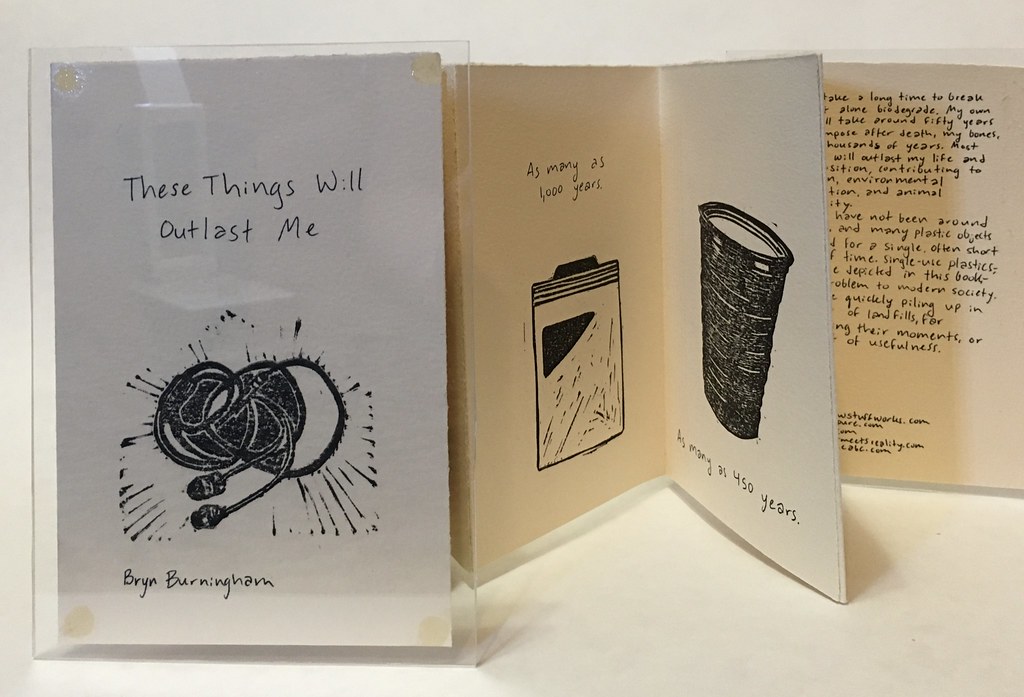
These Things Will Outlast Me
Bryn Burningham
Utah State University, Logan, UT
artist book, relief print
4.5" x 6.25"
2020
This was originally supposed to be a piece with letterpress text, but I lost access to campus and therefore the presses before the assignment was introduced. I hand printed all of the images, and hand-wrote the text in my sub-par handwriting, not ideal. Snapping the plexiglass cover didn't go as smoothly as intended either; I had to buy a plexiglass scoring tool, and it ended up being much lower in quality than the studio tools I'm used to. Despite the challenges, I enjoy how the piece turned out and it was good to have a project early on in quarantine.

Almost Immortal
Bryn Burningham
Utah State University, Logan, UT
relief
1.5" x 2.5"
2020
I lost access to the press at my college before I could print this image. All of the printing was done in my makeshift room studio. I was lucky enough to already have several tools and inks on hand, I’ve been purchasing printmaking ephemera since I graduated from my AFA program and through my BFS program. As I drew and carved this image, I thought about how fragile this object was. My earbuds were already starting to break at the joint between the bud and the volume remote. This object only lasted me around a year but will live on, useless for hundreds of years. Broken. It will outlast my living life.

The Water Tower
Emma Wasend
Carleton College, Northfield, MN
etching
10’’ x 8’'
I was working from home, sending plates back and forth with my professor, and my shipment got lost in the mail, which I guess is more common than usual in these Covid times. I’ve been thinking about resources, and how we prepare for the times when we cannot use manpower to retrieve those resources, and above me in my usual morning run sits a water tower, which is the subject of my print. Water towers are amazing, architectural, beautiful and essential especially when towns lose power. With the reduction in essential jobs, some that remain are to do with water, which of course makes sense.
Artists Included
Merrick Adams, Jill Adler, Isabel Arevalo, Nicole Arnold, Veda Rives Aukerman & Meda Rives Smith, Kristen Bartel, Emily Bealer, Joe Beam, Amit Cassandra Ben-Baruch, Tay Bomstein, Savannah Bowling, Phyllis Bramson, Matthew Brunetti, Bryn Burningham, Kristen Byrne, Catherine Chauvin, Alexis Coffel, EJ Coolidge, Therese Croft, Jessica Dehen, Juliebeth Delgado, Allison Denny, Ashley DeVan, Valerie Dibble, Kaitlyn DiBiase, Autumn Doney, Jess Dowell, Kate Duffy, Julia Edelmann, Tracy Featherstone, Domenic Feola, Peytin Fitzgerald, Kate Forer, Liam de Freese, Steve Garst, Elżbieta Gibulska, Judy Glantzman, Kendall Gott, Taylor Guntharp, Cedar Heffelfinger, Manuel Hernandez, Lydia Hershauer, Sara Hess, Sue Hettmansperger, Brandon Huelskamp, Ina Kaur, Sarah Kinard, Lisa Jungmin Lee, Brooke Leland, Jiaqi Li, Chenyu Lin, Mallory Lucas, Upneet Kaur Mair, Rachel Mantel, Libby Marx, Simon Mason, Elena Masrour, Leslie Mata, Roberto Torres Mata, Sarah McClymond, Matthew McLaughlin, Hugh Merrill, Dilara Miller, David Mohallatee, Virginia Moore, Donna Moran, Tess Murphy, Meli Nava, Haley Noelle, Rhea Nowak, Sam Oetinger and Jordan Munoz, Shivam Pawar, Margaret Perez, Johnny Plastini, Tyrone Quigley, Breanna Rechtenbaugh, Macy Reynolds, Grace Ritchie, Jess Rodriguez, Sophie Rogers, Quinn Russo, Kristin Sarette, Carley Schmidt, Erika Shiba, Neoshia Shockley, Robert Shoemaker, Holly Patton Shull, Branstarr Sihanath, Skylar Silva, Rachel Singel, Maddi Bryce Smith, Mike Sonnichsen, Carlin Spinney, Yanqi Sun, Taro Takizawa, Jackson Taylor, Sean Topel, Cody Tracy, Francesca Travagli, Livie Wang, Sarah Whorf, Lily Wieleba, Ezra Wilson, Julia Wozny, Jenny Wu, Anna Yates, and Nesto Yero